产业新知热门
 加国央行再次疯狂加息 月供将暴涨 物价竟会这样变化
加国央行再次疯狂加息 月供将暴涨 物价竟会这样变化
 无人幸免的购物节“大逃杀”
无人幸免的购物节“大逃杀”
 兼职做自媒体这些天:有人年入五块四,有人时薪一百二
兼职做自媒体这些天:有人年入五块四,有人时薪一百二
 瞄准数亿过敏人群,以过敏数字疗法为切点,杭州数智医掘金新蓝海
瞄准数亿过敏人群,以过敏数字疗法为切点,杭州数智医掘金新蓝海
 武汉大学疑似出现霍乱病例
武汉大学疑似出现霍乱病例
 期货不严格止损是超短线交易失败的根源
期货不严格止损是超短线交易失败的根源
 ,精细赛道也能走到上市!
,精细赛道也能走到上市!
 预制菜,会有“刺客”吗
预制菜,会有“刺客”吗

推荐资讯
 让区块链变成人人可用的工具,上海原创Web3.0操作系统是如何诞生的
让区块链变成人人可用的工具,上海原创Web3.0操作系统是如何诞生的
 隐私之变|自我主张时代变革,从构建WEB3.0的ID体系开始
隐私之变|自我主张时代变革,从构建WEB3.0的ID体系开始
 被投资圈盯上,风头超过元宇宙,Web3.0到底是啥?
被投资圈盯上,风头超过元宇宙,Web3.0到底是啥?
 Web3.0,勾勒下一代互联网模样
Web3.0,勾勒下一代互联网模样
 为什么说中国汽车产业已经真正“支棱”起来了
为什么说中国汽车产业已经真正“支棱”起来了
 我在新能源汽车行业打工10年:从月薪2千涨至年薪40万,终于熬出头
我在新能源汽车行业打工10年:从月薪2千涨至年薪40万,终于熬出头
 对话梅宏院士:数字化转型不是想不想,而是必须转
对话梅宏院士:数字化转型不是想不想,而是必须转
 王兴继续“电商零售梦”:告别社区团购 美团优选变身明日达超市
王兴继续“电商零售梦”:告别社区团购 美团优选变身明日达超市

顶流明星考编,网友挨骂:世道变坏,就是从嘲讽普通人努力开始的

来源: 脆皮先生 WPR 整理并推荐阅读,转载请注明来源 。如涉及版权等问题请及时与我们联系(微信:18769443936),我们将在第一时间处理。

169. Don't let yesterday use up too much of today. 别留念昨天了,把握好今天吧。(Will Rogers) 170. If you are not brave enough, no one w ill back you up. 你不勇敢,没人替你坚强。171. If you don't build your dream, someone will hire you to build theirs. 如果你没有梦想,那么你只能为别人的梦想打工。172. Beauty is all around, if you 在意的那些结根本算不了什么。183. The key to acquiring proficiency in any task is repetition. 任何事情成功关键都是熟能生巧。《生活大爆炸》 184. You can be happy no matter what. 开心一点吧,管它会怎样。185. A good plan today is better than a perfect plan tomorrow. 今天的好计划胜过明天的完美计划。186. Nothing is impossible, the word itself says 'I'm possible'! 一切皆有可能!“不可能”的意思是:“不,可能。”(奥黛丽·赫本) 187. Life isn't fair, but no matter your circumstances, you have to give it your all. 生活是不公平的,不管你的境遇如何,你只能全力以赴。188. No matter how hard it is, just keep going because you only fail when you give up. 无论多么艰难,都要继续前进,因为只有你放弃的那一刻,你才输了。When Paul Jobs was mustered out of the Coast Guard after World War II, he made a wager with his crewmates. They had arrived in San Francisco, where their ship was decommissioned, and Paul bet that he would find himself a wife within two weeks. He was a taut, tattooed engine mechanic, six feet tall, with a passing resemblance to James Dean. But it wasn’t his looks that got him a date with Clara Hagopian, a sweet-humored daughter of Armenian immigrants. It was the fact that he and his friends had a car, unlike the group she had originally planned to go out with that evening. Ten days later, in March 1946, Paul got engaged to Clara and won his wager. It would turn out to be a happy marriage, one that lasted until death parted them more than forty years later. Paul Reinhold Jobs had been raised on a dairy farm in Germantown, Wisconsin. Even though his father was an alcoholic and sometimes abusive, Paul ended up with a gentle and calm disposition under his leathery exterior. After dropping out of high mechanic until, at age nineteen, he joined the Coast Guard, even though he didn’t know how to swim. He was deployed on the USS General M. C. Meigs and spent much of the war ferrying troops to Italy for General Patton. His talent as a machinist and fireman earned him commendations, but he occasionally found himself in minor trouble and never rose above the rank of seaman. Clara was born in New Jersey, where her parents had landed after fleeing the Turks in Armenia, and they moved to the Mission District of San Francisco when she was a child. She had a secret that she rarely mentioned to anyone: She had been married before, but her husband had been killed in the war. So when she met Paul Jobs on that first date, she was primed to start a new life. Clara, however, loved San Francisco, and in 1952 she convinced her husband to move back there. They got an apartment in the Sunset District facing the Pacific, just south of Golden Gate Park, and he took a job working for a finance company as a “repo man,” picking the locks of cars whose owners hadn’t paid their loans and repossessing them. He also bought, repaired, and sold some of the cars, making a decent enough living in the process. There was, however, something missing in their lives. They wanted children, but Clara had suffered an ectopic pregnancy, in which the fertilized egg was implanted in a fallopian tube rather than the uterus, and she had been unable to have any. So by 1955, after nine years of marriage, they were looking to adopt a child. Like Paul Jobs, Joanne Schieble was from a rural Wisconsin family of German heritage. Her father, Arthur Schieble, had immigrated to the outskirts of Green Bay, where he and his wife owned a mink farm and dabbled successfully in various other businesses, including real estate and photoengraving. He was very strict, especially regarding his daughter’s relationships, and he had strongly disapproved of her first love, an artist who was not a Catholic. Thus it was no surprise that he threatened to cut Joanne off completely when, as a graduate student at the University of Wisconsin, she fell in love with Abdulfattah “John” Jandali, a Muslim teaching assistant from Syria. Jandali was the youngest of nine children in a prominent Syrian family. His father owned oil refineries and multiple other businesses, with large holdings in Damascus and Homs, and at one point pretty much controlled the price of wheat in the region. His mother, he later said, was a “traditional Muslim woman” who was a “conservative, obedient housewife.” Like the Schieble family, the Jandalis put a premium on education. Abdulfattah was sent to a Jesuit boarding school, even though he was Muslim, and he got an undergraduate degree at the American University in Beirut before entering the University of Wisconsin to pursue a doctoral degree in political science. In the summer of 1954, Joanne went with Abdulfattah to Syria. They spent two months in Homs, where she learned from his family to cook Syrian dishes. When they returned to Wisconsin she discovered that she was pregnant. They were both twenty-three, but they decided not to get married. Her father was dying at the time, and he had threatened to disown her if she wed Abdulfattah. Nor was abortion an easy option in a small Catholic community. So in early 1955, Joanne traveled to San Francisco, where she was taken into the care of a kindly doctor who sheltered unwed mothers, delivered their babies, and quietly arranged closed adoptions. Joanne had one requirement: Her child must be adopted by college graduates. So the doctor arranged for the baby to be placed with a lawyer and his wife. But when a boy was born—on February 24, 1955—the designated couple decided that they wanted a girl and backed out. Thus it was that the boy became the son not of a lawyer but of a high school dropout with a passion for mechanics and his salt-of-the-earth wife who was working as a bookkeeper. Paul and Clara named their new baby Steven Paul Jobs. When Joanne found out that her baby had been placed with a couple who had not even graduated from high school, she refused to sign the adoption papers. The standoff lasted weeks, even after the baby had settled into the Jobs household. Eventually Joanne relented, with the stipulation that the couple promise—indeed sign a pledge—to fund a savings account to pay for the boy’s college education. There was another reason that Joanne was balky about signing the adoption papers. Her father was about to die, and she planned to marry Jandali soon after. She held out hope, she would later tell family members, sometimes tearing up at the memory, that once they were married, she could get their 别让梦想只停留在梦里。181. A day without laughter is a day wasted. 没有笑声的一天是浪费了的一天。(卓别林) 182. Travel and see the world; afterwards, you will be able to put your concerns in perspective. 去旅行吧,见的世面多了,你会发现原来在意的那些结根本算不了什么。183. The key to acquiring proficiency in any task is repetition. 任何事情成功关键都是熟能生巧。《生活大爆炸》 184. You can be happy no matter what. 开心一点吧,管它会怎样。baby boy back. Arthur Schieble died in August 1955, after the adoption was finalized. Just after Christmas that year, Joanne and Abdulfattah were married in St. Philip the Apostle Catholic Church in Green Bay. He got his PhD in international politics the next year, and then they had another child, a girl named Mona. After she and Jandali porced in 1962, Joanne embarked on a dreamy and peripatetic life that her daughter, who grew up to become the acclaimed novelist Mona Simpson, would capture in her book Anywhere but Here. Because Steve’s adoption had been closed, it would be twenty years before they would all find each other. Steve Jobs knew from an early age that he was adopted. “My parents were very open with me about that,” he recalled. He had a vivid memory of sitting on the lawn of his house, when he was six or seven years old, telling the girl who lived across the street. “So does that mean your real parents didn’t want you?” the girl asked. “Lightning bolts went off in my head,” according to Jobs. “I remember running into the house, crying. And my parents said, ‘No, you have to understand.’ They were very serious and looked me straight in the eye. They said, ‘We specifically picked you out.’ Both of my parents said that and repeated it slowly for me. And they put an emphasis on every word in that sentence.” Abandoned. Chosen. Special. Those concepts became part of who Jobs was and how he regarded himself. His closest friends think that the knowledge that he was given up at birth left some scars. “I think his desire for complete control of whatever he makes derives directly from his personality and the fact that he was abandoned at birth,” said one longtime colleague, Del Yocam. “He wants to control his environment, and he sees the product as an extension of himself.” Greg Calhoun, who became close to Jobs right after college, saw another effect. “Steve talked to me a lot about being abandoned and the pain that caused,” he said. “It made him independent. He followed the beat of a different drummer, and that came from being in a different world than he was born into.” Later in life, when he was the same age his biological father had been when he abandoned him, Jobs would father and abandon a child of his own. (He eventually took responsibility for her.) Chrisann Brennan, the mother of that child, said that being put up for adoption left Jobs “full of broken glass,” and it helps to explain some of his behavior. “He who is abandoned is an abandoner,” she said. Andy Hertzfeld, who worked with Jobs at Apple in the early 1980s, is among the few who remained close to both Brennan and Jobs. “The key question about Steve is why he can’t control himself at times from being so reflexively cruel and harmful to some people,” he said. “That goes back to being abandoned at birth. The real underlying problem was the theme of abandonment in Steve’s life.” Jobs dismissed this. “There’s some notion that because I was abandoned, I worked very hard so I could do well and make my parents wish they had me back, or some such nonsense, but that’s ridiculous,” he insisted. “Knowing I was adopted may have made me feel more independent, but I have never felt abandoned. I’ve always felt special. My parents made me feel special.” He would later bristle whenever anyone referred to Paul and Clara Jobs as his “adoptive” parents or implied that they were not his “real” parents. “They were my parents 1,000%,” he said. When speaking about his biological parents, on the other hand, he was curt: “They were my sperm and egg bank. That’s not harsh, it’s just the way it was, a sperm bank thing, nothing more.” Silicon Valley The childhood that Paul and Clara Jobs created for their new son was, in many ways, a stereotype of the late 1950s. When Steve was two they adopted a girl they named Patty, and three years later they moved to a tract house in the suburbs. The finance company where Paul worked as a repo man, CIT, had transferred him down to its Palo Alto office, but he could not afford to live there, so they landed in a subpision in Mountain View, a less expensive town just to the south. There Paul tried to pass along his love of mechanics and cars. “Steve, this is your workbench now,” he said as he marked off a section of the table in their garage. Jobs remembered being impressed by his father’s focus on craftsmanship. “I thought my dad’s sense of design was pretty good,” he said, “because he knew how to build anything. If we needed a cabinet, he would build it. When he built our fence, he gave me a hammer so I could work with him.” Fifty years later the fence still surrounds the back and side yards of the house in Mountain View. As Jobs showed it off to me, he caressed the stockade panels and recalled a lesson that his father implanted deeply in him. It was important, his father said, to craft the backs of cabinets and fences properly, even though they were hidden. “He loved doing things right. He even cared about the look of the parts you couldn’t see.” His father continued to refurbish and resell used cars, and he festooned the garage with pictures of his favorites. He would point out the detailing of the design to his son: the lines, the vents, the chrome, the trim of the seats. After work each day, he would change into his dungarees and retreat to the garage, often with Steve tagging along. “I figured I could get him nailed down with a little mechanical ability, but he really wasn’t interested in getting his hands dirty,” Paul later recalled. “He never really cared too much about m189. It requires hard work to give off an appearance of effortlessness. 你必须十分努力,才能看起来毫不费力。190. Life is like riding a bicycle.To keep your balance,you must keep moving. 人生就像骑单车,只有不断前进,才能保持平衡。(爱因斯坦) 191. Be thankful for what you have.You'll end up having more. 拥有一颗感恩的心,最终你会得到更多。192. Beauty is how you feel inside, and it reflects in your eyes. 美是一种内心的感觉,并反映在你的眼睛里。(索菲亚·罗兰) 193. Friendship doubles your joys, and pides your sorrows. 朋友的作用,就是让你快乐加倍,痛苦减半。194. When you long for something sincerely, the whole world will help you. 当你真心渴望某样东西时,整个宇宙都会来帮忙。echanical things.” “I wasn’t that into fixing cars,” Jobs admitted. “But I was eager to hang out with my dad.” Even as he was growing more aware that he had been adopted, he was becoming more attached to his father. One day when he was about eight, he discovered a photograph of his father from his time in the Coast Guard. “He’s in the engine room, and he’s got his shirt off and looks like James Dean. It was one of those Oh wow moments for a kid. Wow, oooh, my parents were actually once very young and really good-looking.” Through cars, his father gave Steve his first exposure to electronics. “My dad did not have a deep understanding of electronics, but he’d encountered it a lot in automobiles and other things he would fix. He showed me the rudiments of electronics, and I got very interested in that.” Even more interesting were the trips to scavenge for parts. “Every weekend, there’d be a junkyard trip. We’d be looking for a generator, a carburetor, all sorts of components.” He remembered watching his father negotiate at the counter. “He was a good bargainer, because he knew better than the guys at the counter what the parts should cost.” This helped fulfill the pledge his parents made when he was adopted. “My college fund came from my dad paying $50 for a Ford Falcon or some other beat-up car that didn’t run, working on it for a few weeks, and selling it for $250—and not telling the IRS.” The Jobses’ house and the others in their neighborhood were built by the real estate developer Joseph Eichler, whose company spawned more than eleven thousand homes in various California subpisions between 1950 and 1974. Inspired by Frank Lloyd Wright’s vision of simple modern homes for the American “everyman,” Eichler built inexpensive houses that featured floor-to-ceiling glass walls, open floor plans, exposed post-and-beam construction, concrete slab floors, and lots of sliding glass doors. “Eichler did a great thing,” Jobs said on one of our walks around the neighborhood. “His houses were smart and cheap and good. They brought clean design and simple taste to lower-income people. They had awesome little features, like radiant heating in the floors. You put carpet on them, and we had nice toasty floors when we were kids.” Jobs said that his appreciation for Eichler homes instilled in him a passion for making nicely designed products for the mass market. “I love it when you can bring really great design and simple capability to something that doesn’t cost much,” he said as he pointed out the clean elegance of the houses. “It was the original vision for Apple. That’s what we tried to do with the first Mac. That’s what we did with the iPod.” Across the street from the Jobs family lived a man who had become successful as a real estate agent. “He wasn’t that bright,” Jobs recalled, “but he seemed to be making a fortune. So my dad thought, ‘I can do that.’ He worked so hard, I remember. He took these night classes, passed the license test, and got into real estate. Then the bottom fell out of the market.” As a result, the family found itself financially strapped for a year or so while Steve was in elementary school. His mother took a job as a bookkeeper for Varian Associates, a company that made scientific instruments, and they took out a second mortgage. One day his fourth-grade teacher asked him, “What is it you don’t understand about the universe?” Jobs replied, “I don’t understand why all of a sudden my dad is so broke.” He was proud that his father never adopted a servile attitude or slick style that may have made him a better salesman. “You had to suck up to people to sell real estate, and he wasn’t good at that and it wasn’t in his nature. I admired him for that.” Paul Jobs went back to being a mechanic. His father was calm and gentle, traits that his son later praised more than emulated. He was also resolute. Jobs described one exampl What made the neighborhood different from the thousands of other spindly-tree subpisions across America was that even the ne’er-do-wells tended to be engineers. “When we moved here, there were apricot and plum orchards on all of these corners,” Jobs recalled. “But it was beginning to boom because of military investment.” He soaked up the history of the valley and developed a yearning to play his own role. Edwin Land of Polaroid later told him about being asked by Eisenhower to help build the U-2 spy plane cameras to see how real the Soviet threat was. The film was dropped in canisters and returned to the NASA Ames Research Center in Sunnyvale, not far from where Jobs lived. “The first computer terminal I ever saw was when my dad brought me to the Ames Center,” he said. “I fell totally in love with it.” Other defense contractors sprouted nearby during the 1950s. The Lockheed Missiles and Space Division, which built submarine-launched ballistic missiles, was founded in 1956 next to the NASA Center; by the time Jobs moved to the area four years later, it employed twenty thousand people. A few hundred yards away, Westinghouse built facilities that produced tubes and electrical transformers for the missile systems. “You had all these military companies on the cutting edge,” he recalled. “It was mysterious and high-tech and made living here very exciting.” In the wake of the defense industries there arose a booming economy based on technology. Its roots stretched back to 1938, when David Packard and his new wife moved into a house in Palo Alto that had a shed where his friend Bill Hewlett was soon ensconced. The house had a garage—an appendage that would prove both useful and iconic in the valley—in which they tinkered around until they had their first product, an audio oscillator. By the 1950s, Hewlett-Packard was a fast-growing company making technical instruments. Fortunately there was a place nearby for entrepreneurs who had outgrown their garages. In a move that would help transform the area into the cradle of the tech revolution, Stanford University’s dean of engineering, Frederick Terman, created a seven-hundred-acre industrial park on university land for private companies that could commercialize the ideas of his students. Its first tenant was Varian Associates, where Clara Jobs worked. “Terman came up with this great idea that did more than anything to cause the tech industry to grow up here,” Jobs said. By the time Jobs was ten, HP had nine thousand employees and was the blue-chip company where every engineer seeking financial stability wanted to work. The most important technology for the region’s growth was, of course, the semiconductor. William Shockley, who had been one of the inventors of the transistor at Bell Labs in New Jersey, moved out to Mountain View and, in 1956, started a company to build transistors using silicon rather than the more expensive germanium that was then commonly used. But Shockley became increasingly erratic and abandoned his silicon transistor project, which led eight of his engineers—most notably Robert Noyce and Gordon Moore—to break away to form Fairchild Semiconductor. That company grew to twelve thousand employees, but it fragmented in 1968, when Noyce lost a power struggle to become CEO. He took Gordon Moore and founded a company that they called Integrated Electronics Corporation, which they soon smartly abbreviated to Intel. Their third employee was Andrew Grove, who later would grow the company by shifting its focus from memory chips to microprocessors. Within a few years there would be more than fifty companies in the area making semiconductors. The exponential growth of this industry was correlated with the phenomenon famously discovered by Moore, who in 1965 drew a graph of the speed of integrated circuits, based on the number of transistors that could be placed on a chip, and showed that it doubled about every two years, a trajectory that could be expected to continue. This was reaffirmed in 1971, when Intel was able to etch a complete central processing unit onto one chip, the Intel 4004, tronic amplifier. “So I raced home, and I told my dad that he was wrong.” “No, it needs an amplifier,” his father assured him. When Steve protested otherwise, his father said he was crazy. “It can’t work without an amplifier. There’s some trick.” “I kept saying no to my dad, telling him he had to see it, and finally he actually walked down with me and saw it. And he said, ‘Well I’ll be a bat out of hell.’” Jobs recalled the incident vividly because it was his first realization that his father did not know everything. Then a more disconcerting discovery began to dawn on him: He was smarter than his parents. He had always admired his father’s competence and savvy. “He was not an educated man, but I had always thought he was pretty damn smart. He didn’t read much, but he could do a lot. Almost everything mechanical, he could figure it out.” Yet the carbon microphone incident, Jobs said, began a jarring process of realizing that he was in fact more clever and quick than his parents. “It was a very big moment that’s burned into my mind. When I realized that I was smarter than my parents, I felt tremendous shame for having thought that. I will never forget that moment.” This discovery, he later told friends, along with the fact that he was adopted, made him feel apart—detached and separate—from both his family and the world. Another layer of awareness occurred soon after. Not only did he discover that he was brighter than his parents, but he discovered that they knew this. Paul and Clara Jobs were loving parents, and they were willing to adapt their lives to suit a son who was very smart—and also willful. They would go to great lengths to accommodate him. And soon Steve discovered this fact as well. “Both my parents got me. They felt a lot of responsibility once they sensed that I was special. They found ways to keep feeding me stuff and putting me in better schools. They were willing to defer to my needs.” So he grew up not only with a sense of having once been abandoned, but also with a sense that he was special. In his own mind, that was more important in the formation of his personality. School Even before Jobs started elementary school, his mother had taught him how to read. This, however, led to some problems once he got to school. “I was kind of bored for the first few years 在这种情况下,俄罗斯和欧洲正兴建一条新的天然气运输管道,这就是北溪-2项目,这个项目全长1224公里,从俄罗斯穿过波罗的海,将天然气运输到德国和其它国家,欧洲很多国家都参与了这条管道项目的建设,毕竟这是欧洲国家的民生工程。一旦这条管道建设完成,可以为欧洲提供每年330亿立方米的天然气,可以满足欧洲对天然气十分之一的需求,这可是非常大的。它是气态行星没有实体表面,由90%的氢和10%的氦(原子数之比, 75/25%的质量比)及微量的甲烷、水、氨水和“石头”组成。这与形成整个太阳系的原始的太阳系星云的组成十分相似。木星可能有一个石质的内核,相当于10-15个地球的质量。内核上则是大部分的行星物质集结地,以液态氢的形式存在。液态金属氢由离子化的质子与电子组成(类似于太阳的内部,不过温度低多了)。木星共有67颗木卫。按距离木星中心由近及远的次序为:木卫十六、木卫十四、木卫五、木卫十五、木卫一、木卫二、木卫三、木卫四、木卫十三、木卫六、木卫十、木卫七、木卫十二、木卫十一、木卫八和木卫九。[46] 水星是最接近太阳的行星。水星的半径约为2440公里,在八大行星中是最小的。水星昼夜温差极大,白天摄氏 430 度,晚上约可达零下170 度,是太阳系八大行星中温差最大的一个行星。[47] 水星的外大气层非常稀薄,是由水星表面和太阳风中的原子和离子构成。[48] 科学家确认水星表面含有丰富的碳,认为碳是水星表面呈黑色的原因,水星表面的岩石是由低重量百分比的石墨碳构成。[49] “好奇号”火星探测器在火星表面采集样本 “好奇号”火星探测器在火星表面采集样本 [50] 火星是地球的近邻,是太阳系由内往外数第四颗行星。直径6794km,体积为地球的15%,质量为地球的11%。火星表面是一个荒凉的世界,空气中二氧化碳占了95%。火星大气十分稀薄,密度还不到地球大气的1%,因而根本无法保存热量。这导致火星表面温度极低,很少超过0℃,在夜晚,最低温度则可达到-123℃。火星被称为红色的行星,这是因为它表面布满了氧化物,因而呈现出铁锈红色。其表面的大部分地区都是含有大量的红色氧化物的大沙漠,还有赭色的砾石地和凝固的熔岩流。火星上常常有猛烈的大风,大风扬起沙尘能形成可以覆盖火星全球的特大型沙尘暴。每次沙尘暴可持续数个星期。火星两极的冰冠和火星大气中含有水份。从火星表面获得的探测数据证明,在远古时期八颗行星,直径49532千米。海王星绕太阳运转的轨道半径为45亿千米,公转一周需要165年。海王星的直径和天王星类似,质量比天王星略大一些。海王星和天王星的主要大气成分都是氢和氦,内部结构也极为相近,所以说海王星与天王星是一对孪生兄弟。[55] 海王星有太阳系最强烈的风,测量到的时速高达2100公里。海王星云顶的温度是-218 °C,是太阳系最冷的地区之一。海王星核心的温度约为7000 °C,可以和太阳的表面比较。海王星在1846年9月23日被发现,是唯一利用数学预测而非有计划的观测发现的行星。[56] 冥王星,位于海王星以外的柯伊伯带内侧,是柯伊伯带中已知的最大天体。[57] 直径约为2370±20km,是地球直径的18.5%。[58] 2006年8月24日,国际天文学联合会大会24日投票决定,不再将传统九大行星之一的冥王星视为行星,而将其列入“矮行星”。大会通过的决议规定,“行星”指的是围绕太阳运转、自身引力足以克服其刚体力而使天体呈圆球状、能够清除其轨道附近其他物体的天体。在太阳系传统的“九大行星”中,只有水星、金星、地球、火星、木星、土星、天王星和海王星符合这些要求。冥王星由于其轨道与海王星的轨道相交,不符合新的行星定义,因此被自动降级为“矮行星”。[59] 冥王星的表面温度大概在-238到-228℃之间。冥王星的成份由70%岩石和30%冰水混合而成的。地表上光亮的部分可能覆盖着一些固体氮以及少量 卫星拍月球经过地球,可见清晰月球背面 卫星拍月球经过地球,可见清晰月球背面 [60] 的固体甲烷和一氧化碳,冥王星表面的黑暗部分可能是一些基本的有机物质或是由宇宙射线引发的光化学反应。冥王星的大气层主要由氮和少量的一氧化碳及甲烷组成。大气极其稀薄,地面压强只有少量微帕。[61] 地球是离太阳第三颗行星,是我们人类的家乡,尽管地球是太阳系中一颗普通的行星,但它在许多方面都是独一无二的。比如,它是太阳系中唯一一颗面积大部分被水覆盖的行星,也是目前所知唯一一颗有生命存在的星球。质量M=5.9742 ×10^24 公斤,表面温度:t = - 30 ~ +45。[62] 英国科研人员在《天体生物学》杂志上报告说,如果没有小行星撞击等可能剧烈改变环境的事件发生,地球适宜人类居住的时间还剩约17.5亿年,不过人为造成的气候变化可能缩短这一时间。[63] 彗星是由灰尘和冰块组成的太阳系中的一类小天体,绕日运动。[64] 科学家使用探测器对彗星的化学遗留物进行分析,发现其主要成份为氨、甲烷、硫化氢、氰化氢和甲醛。科学家得出结论称,彗星的气味闻起来像是臭鸡蛋、马尿、酒精和苦杏仁的气味综合。[65-66] “67P/楚留莫夫-格拉希门克”彗星 “67P/楚留莫夫-格拉希门克”彗星 [67] 在太阳系的周围还包裹着一个庞大的“奥尔特云”。星云内分布着不计其数的冰块、雪团和碎石。其中的某些会受太阳引力影响飞入内太阳系,这学说,在原有的轨道(或称小天体轨道)上又增加了更多的天体运行轨道。这一模式称每颗行星都沿着一个小轨道作圆周运行,而小轨道又沿着该行星的大轨道绕地球作圆周运动。几百年之后,这一模式的漏洞越来越明显。科学家们又在这个模式上增加了许多轨道,行星就这样沿着一道又一道的轨道作圆周运动。哥白尼想用“现代”(16世纪的)技术来改进托勒密的测量结果,以期取消一些小轨道。在长达近20年的时间里,哥白尼不辞辛劳日夜测量行星的位置,但其测量获得的结果仍然与托勒密的天体运行模式没有多少差别。哥白尼想知道在另一个运行着的行星上观察这些行星的运行情况会是什么样的。基于这种设想,哥白尼萌发了一个念头:假如地球在运行中,那么这些行星的运行看上去会是什么情况呢?这一设想在他脑海里变得清晰起来了。一年里,哥白尼在不同的时间、不同的距离从地球上观察行星,每一个行星的情况都不相同,这是他意识到地球不可能位于星星轨道的中心。经过20年的观测,哥白尼发现唯独太阳的周年变化不明显。这意味着地球和太阳的距离始终没有改变。如果地球不是宇宙的中心,那么宇宙的中心就是太阳。的发现才使牛顿有能力确定运动定律和万有引力定律。哥白尼的日心宇宙体系既然是时代的产物,它就不能不受到时代的限制。反对神学的不彻底性,同时表现在哥白尼的某些观点上,他的体系是存在缺陷的。哥白尼所指的宇宙是局限在一个小的范围内的,具体来说,他的宇宙结构就是今天我们所熟知的太阳系,即以太阳为中心的天体系统。宇宙既然有它的中心,就必须有它的边界,哥白尼虽然否定了托勒玫的“九重天”,但他却保留了一层恒星天,尽管他回避了宇宙是否有限这个问题,但实际上他是相信恒星天球是宇宙的“外壳”,他仍然相信天体只能按照所谓完美的圆形轨道运动,所以哥白尼的宇宙体系,仍然包含着不动的中心天体。但是作为近代自然科学的奠基人,哥白尼的历史功绩是伟大的。确认地球不是宇宙的中心,而是行星之一,从而掀起了一场天文学上根本性的革命,是人类探求客观真理道路上的里程碑。哥白尼的伟大成就,不仅铺平了通向近代天文学的道路,而且开创了整个自然界科学向前迈进的新时代。从哥白尼时代起,脱离教会束缚的自然科学和哲学开始获得飞跃的发展。哥白尼的科学成就,是他所处时代的产物,又转过来推动了时代的发展。顺应时代变化 十五、六世纪的欧洲,正是从封建社会向资本主义社会转变的关键时期,在这一二百年间,社会发生了巨大的变化。14世纪以前的欧洲,到处是四分五裂的小城邦。后来,随着城市工商业的兴起,特别是采矿和冶金业的发展,涌现了许多新兴的大城市,小城邦有了联合起来组成国家的趋势。到 15世纪末叶,在许多国家里都出现了基本上是中央集权的君主政体。当时的波兰不仅有像克拉科夫、波兹南这样的大城市,也有许多手工业兴盛的城
1
我是脆皮。
这两天热搜上最大的事情,除了安倍遇刺,还有一件。
那就是明星考编。
不久前,易烊千玺等3名青年演员考上国家话剧院的消息,引爆舆论。

国家话剧院是什么单位?
这是中国国家表演最高级的艺术团体。
是无数艺术生毕生追求的理想殿堂。
还是一个正经有编制的铁饭碗。

乍一看这个消息,网友们还没觉得哪里不对。
但越咂摸越不是滋味。
首先,是对这几位演员能力的质疑。
他们是优秀的青年演员吗?
我想是的。
但他们的优秀足以让他们进入中国最顶级的艺术单位吗?
我想还不够。
看看之前被选入国话的演员名单。
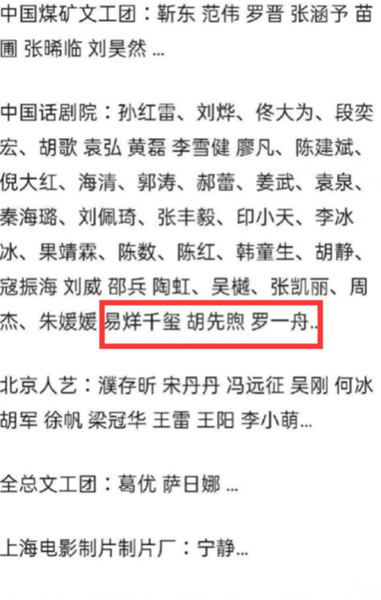
不是倪大红、李雪健这样的老艺术家。
就是段奕宏、廖凡这种有口皆碑的演技派。
作为他们的后辈,这三位的能力,显然并不能服众。
其次,明星考编,到底算不算特权?
比起自身能力欠缺,大家最关心的,还是明星考编是不是和普通人一样,走固定的程序和流程。
因为网友发现,国家话剧院这次招聘,并没有设置笔试。
是以三次面试的结果为准。
那么问题就来了。
据粉丝说,第三次面试的时候,胡先煦还在安徽拍戏……

又是怎么参加的面试呢?
而且要求上明白写着,参加招聘 必须是在校期间非在职人员。
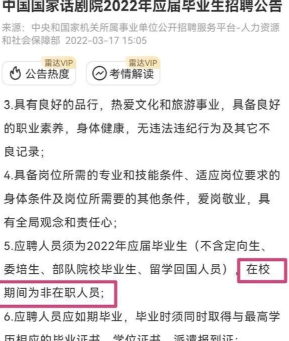
已经拍了好几部戏,还签过公司的他们,符合这个要求吗?
这不扒不要紧,一扒瞬间点燃了大众的怒火。
有人直接开炮:为什么有着天价收入的明星,还要来挤压普通人的生存资源?
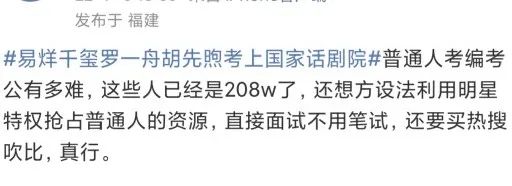
普通人考编有多难,我们深有体会。
今年国考,报名人数史无前例突破200万。
苦读行测、申论,熬过无数个埋头刷题的日夜。
不过是为了得到一份稳定的工作,在城市里扎稳脚跟。
但明星考编,大多为了给自己的履历镀一份金。
他们不用挤独木桥,不用朝九晚五,不用因为几千块的工资发愁。
只要心安理得地享受着体制带来的福利与光环就好了。
拼尽全力都无法上岸的普通人,怎么能没有情绪呢?

很快,国家话剧院做出回应。
称几名演员还没有被正式录取,只是在公示阶段。

至于流程合不合规,有没有享受特权。
我们期待一个更完整的答复。
但我今天文章要写的,也是真正刺痛我和大多数人的,还不是这些。
而是粉丝们的一句话……
2
大家为什么会如此愤怒?
不过是因为我们发现,自己披荆斩棘,一路狂奔才能到达的终点。
一些在金字塔顶尖上的人,可以坐着直升电梯,轻松将所有人甩在身后。
这是公平问题。
但很多粉丝,却站出来给自己的偶像撑腰。
他们说: 就算明星们不去考,你们考得上吗?
你们不过就是一群自己考不上,还要去嫉妒别人的“小镇做题家”罢了。
这五个字,好刺眼。
什么是“小镇做题家”?
就是指出身于小城镇,靠读书刷题而考上大学,取得一点成就的普通人。
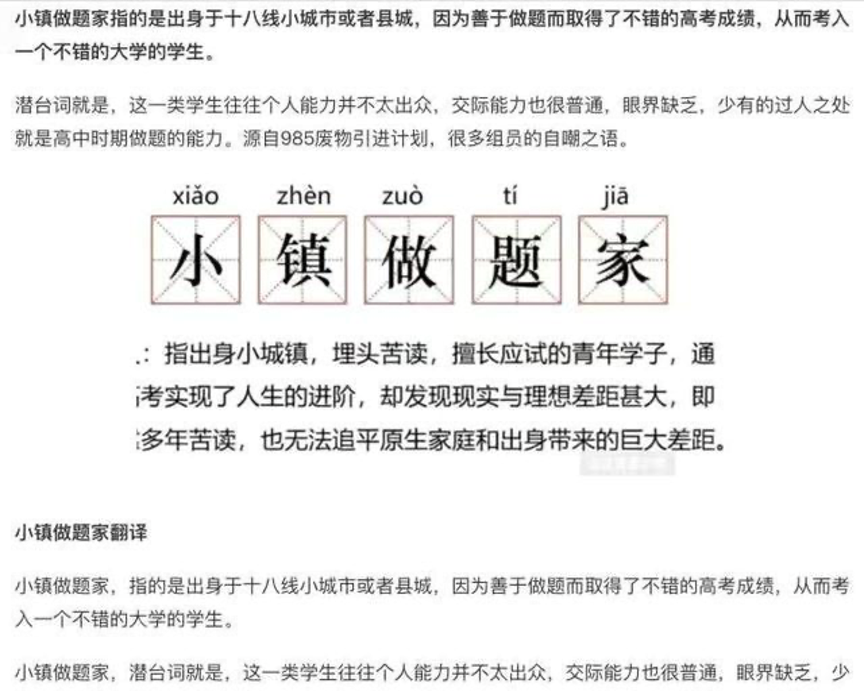
这个词,本身是中性的,常用于自嘲。
可从粉丝们嘴里说出来,就变了味。
有人还直言不讳地写道:因为小镇做题家们无论怎么卷都考不上编制,所以看到明星被录用,才会有一种抢了自己坑的幻觉。
简言之,错的不是考编的明星,错的是心理失衡的我们。
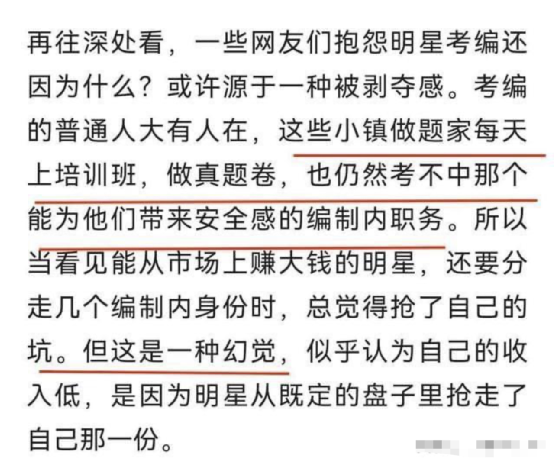
对不起,我真的不能认同。
我们是出身于小地方没错。
我们无权无势,一穷二白。
所以只能努力奔跑,卷生卷死,不敢回头。
好不容易才能在城市里找到自己一席之地,给自己尊严,给家人庇护。
但在有些人嘴里,这一切似乎都成了我们的原罪。
你和他谈公平,他说你是眼红,是嫉妒。
你质疑富人的特权,他说你出身差,没资格。
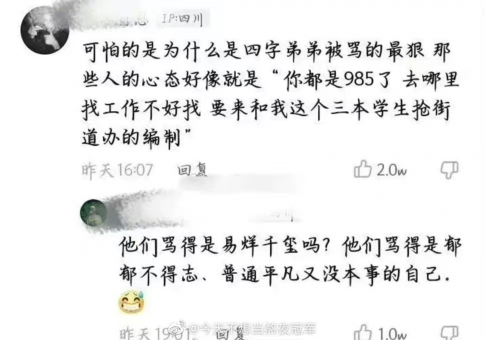
什么时候开始,努力生活,改变命运的人。
得到的不是尊重和掌声,而只有高高在上的嘲讽?
总有人说,这个时代,笑贫不笑娼。
我虽不能完全认同。
但我也觉得,世道变坏,就是从嘲讽普通人努力开始的。
3
白岩松在评价毛坦厂中学的时候说过一段话:
“无论如何,我都无法嘲讽毛坦厂中学的孩子们。他们其中大部分,都是来自打工者家庭,不苦读,没有高考,他们拿什么能拼得过富二代?”
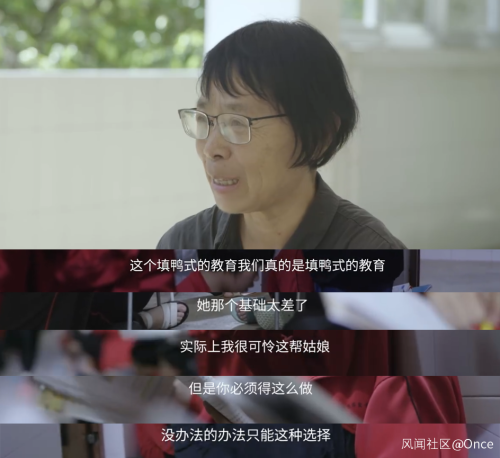
这个世界从来就没什么公平可言。
财富,地位,在我们出生之前,就已经被命运写在了各自的剧本里。
我们生于乡土,有人生在罗马。
为了和他们站在同一高度,我们必须日夜赶路,在脚下垫上无数本书。
当他们嘲讽小镇青年,只会刷题、缺乏眼界的时候。
别忘记,不是每个人都能够生在优越的环境里。
大多数人,只有这一条路可以走。
张桂梅校长被骂“填鸭式”教育华坪女高的孩子们时曾说:
“她们和城里的孩子不能比,只有这样才能读出来。”

没有东风能借的孩子,想要直上青云,只能加快自己的脚步。
我们没有钱,去上那么多的补习班,培养那么多诗词歌赋的兴趣特长。
我们没有势,能在即便自己遭遇社会毒打的时候,也能得到家庭的庇护。
我们只能把自己的整个青春,都埋在一摞又一摞的试卷中。
拼命挤过独木桥,考上一个好大学。
找到一份还不错的工作,自己给自己挣一个好前程。
我并不觉得,这有什么可耻的,又有什么好嘲讽的。
还有什么,能比一个不服输,不认命。
靠自己的努力,改写人生的灵魂,更值得我们鼓掌呢?
真正可耻的,不是身出底层的我们。
而是那些企图用 用一句轻飘飘的小镇做题家,抹杀别人十几年的努力,总以为自己高人一等的精神贵族们。
169. Don't let yesterday use up too much of today. 别留念昨天了,把握好今天吧。(Will Rogers) 170. If you are not brave enough, no one w ill back you up. 你不勇敢,没人替你坚强。171. If you don't build your dream, someone will hire you to build theirs. 如果你没有梦想,那么你只能为别人的梦想打工。172. Beauty is all around, if you 在意的那些结根本算不了什么。183. The key to acquiring proficiency in any task is repetition. 任何事情成功关键都是熟能生巧。《生活大爆炸》 184. You can be happy no matter what. 开心一点吧,管它会怎样。185. A good plan today is better than a perfect plan tomorrow. 今天的好计划胜过明天的完美计划。186. Nothing is impossible, the word itself says 'I'm possible'! 一切皆有可能!“不可能”的意思是:“不,可能。”(奥黛丽·赫本) 187. Life isn't fair, but no matter your circumstances, you have to give it your all. 生活是不公平的,不管你的境遇如何,你只能全力以赴。188. No matter how hard it is, just keep going because you only fail when you give up. 无论多么艰难,都要继续前进,因为只有你放弃的那一刻,你才输了。When Paul Jobs was mustered out of the Coast Guard after World War II, he made a wager with his crewmates. They had arrived in San Francisco, where their ship was decommissioned, and Paul bet that he would find himself a wife within two weeks. He was a taut, tattooed engine mechanic, six feet tall, with a passing resemblance to James Dean. But it wasn’t his looks that got him a date with Clara Hagopian, a sweet-humored daughter of Armenian immigrants. It was the fact that he and his friends had a car, unlike the group she had originally planned to go out with that evening. Ten days later, in March 1946, Paul got engaged to Clara and won his wager. It would turn out to be a happy marriage, one that lasted until death parted them more than forty years later. Paul Reinhold Jobs had been raised on a dairy farm in Germantown, Wisconsin. Even though his father was an alcoholic and sometimes abusive, Paul ended up with a gentle and calm disposition under his leathery exterior. After dropping out of high mechanic until, at age nineteen, he joined the Coast Guard, even though he didn’t know how to swim. He was deployed on the USS General M. C. Meigs and spent much of the war ferrying troops to Italy for General Patton. His talent as a machinist and fireman earned him commendations, but he occasionally found himself in minor trouble and never rose above the rank of seaman. Clara was born in New Jersey, where her parents had landed after fleeing the Turks in Armenia, and they moved to the Mission District of San Francisco when she was a child. She had a secret that she rarely mentioned to anyone: She had been married before, but her husband had been killed in the war. So when she met Paul Jobs on that first date, she was primed to start a new life. Clara, however, loved San Francisco, and in 1952 she convinced her husband to move back there. They got an apartment in the Sunset District facing the Pacific, just south of Golden Gate Park, and he took a job working for a finance company as a “repo man,” picking the locks of cars whose owners hadn’t paid their loans and repossessing them. He also bought, repaired, and sold some of the cars, making a decent enough living in the process. There was, however, something missing in their lives. They wanted children, but Clara had suffered an ectopic pregnancy, in which the fertilized egg was implanted in a fallopian tube rather than the uterus, and she had been unable to have any. So by 1955, after nine years of marriage, they were looking to adopt a child. Like Paul Jobs, Joanne Schieble was from a rural Wisconsin family of German heritage. Her father, Arthur Schieble, had immigrated to the outskirts of Green Bay, where he and his wife owned a mink farm and dabbled successfully in various other businesses, including real estate and photoengraving. He was very strict, especially regarding his daughter’s relationships, and he had strongly disapproved of her first love, an artist who was not a Catholic. Thus it was no surprise that he threatened to cut Joanne off completely when, as a graduate student at the University of Wisconsin, she fell in love with Abdulfattah “John” Jandali, a Muslim teaching assistant from Syria. Jandali was the youngest of nine children in a prominent Syrian family. His father owned oil refineries and multiple other businesses, with large holdings in Damascus and Homs, and at one point pretty much controlled the price of wheat in the region. His mother, he later said, was a “traditional Muslim woman” who was a “conservative, obedient housewife.” Like the Schieble family, the Jandalis put a premium on education. Abdulfattah was sent to a Jesuit boarding school, even though he was Muslim, and he got an undergraduate degree at the American University in Beirut before entering the University of Wisconsin to pursue a doctoral degree in political science. In the summer of 1954, Joanne went with Abdulfattah to Syria. They spent two months in Homs, where she learned from his family to cook Syrian dishes. When they returned to Wisconsin she discovered that she was pregnant. They were both twenty-three, but they decided not to get married. Her father was dying at the time, and he had threatened to disown her if she wed Abdulfattah. Nor was abortion an easy option in a small Catholic community. So in early 1955, Joanne traveled to San Francisco, where she was taken into the care of a kindly doctor who sheltered unwed mothers, delivered their babies, and quietly arranged closed adoptions. Joanne had one requirement: Her child must be adopted by college graduates. So the doctor arranged for the baby to be placed with a lawyer and his wife. But when a boy was born—on February 24, 1955—the designated couple decided that they wanted a girl and backed out. Thus it was that the boy became the son not of a lawyer but of a high school dropout with a passion for mechanics and his salt-of-the-earth wife who was working as a bookkeeper. Paul and Clara named their new baby Steven Paul Jobs. When Joanne found out that her baby had been placed with a couple who had not even graduated from high school, she refused to sign the adoption papers. The standoff lasted weeks, even after the baby had settled into the Jobs household. Eventually Joanne relented, with the stipulation that the couple promise—indeed sign a pledge—to fund a savings account to pay for the boy’s college education. There was another reason that Joanne was balky about signing the adoption papers. Her father was about to die, and she planned to marry Jandali soon after. She held out hope, she would later tell family members, sometimes tearing up at the memory, that once they were married, she could get their 别让梦想只停留在梦里。181. A day without laughter is a day wasted. 没有笑声的一天是浪费了的一天。(卓别林) 182. Travel and see the world; afterwards, you will be able to put your concerns in perspective. 去旅行吧,见的世面多了,你会发现原来在意的那些结根本算不了什么。183. The key to acquiring proficiency in any task is repetition. 任何事情成功关键都是熟能生巧。《生活大爆炸》 184. You can be happy no matter what. 开心一点吧,管它会怎样。baby boy back. Arthur Schieble died in August 1955, after the adoption was finalized. Just after Christmas that year, Joanne and Abdulfattah were married in St. Philip the Apostle Catholic Church in Green Bay. He got his PhD in international politics the next year, and then they had another child, a girl named Mona. After she and Jandali porced in 1962, Joanne embarked on a dreamy and peripatetic life that her daughter, who grew up to become the acclaimed novelist Mona Simpson, would capture in her book Anywhere but Here. Because Steve’s adoption had been closed, it would be twenty years before they would all find each other. Steve Jobs knew from an early age that he was adopted. “My parents were very open with me about that,” he recalled. He had a vivid memory of sitting on the lawn of his house, when he was six or seven years old, telling the girl who lived across the street. “So does that mean your real parents didn’t want you?” the girl asked. “Lightning bolts went off in my head,” according to Jobs. “I remember running into the house, crying. And my parents said, ‘No, you have to understand.’ They were very serious and looked me straight in the eye. They said, ‘We specifically picked you out.’ Both of my parents said that and repeated it slowly for me. And they put an emphasis on every word in that sentence.” Abandoned. Chosen. Special. Those concepts became part of who Jobs was and how he regarded himself. His closest friends think that the knowledge that he was given up at birth left some scars. “I think his desire for complete control of whatever he makes derives directly from his personality and the fact that he was abandoned at birth,” said one longtime colleague, Del Yocam. “He wants to control his environment, and he sees the product as an extension of himself.” Greg Calhoun, who became close to Jobs right after college, saw another effect. “Steve talked to me a lot about being abandoned and the pain that caused,” he said. “It made him independent. He followed the beat of a different drummer, and that came from being in a different world than he was born into.” Later in life, when he was the same age his biological father had been when he abandoned him, Jobs would father and abandon a child of his own. (He eventually took responsibility for her.) Chrisann Brennan, the mother of that child, said that being put up for adoption left Jobs “full of broken glass,” and it helps to explain some of his behavior. “He who is abandoned is an abandoner,” she said. Andy Hertzfeld, who worked with Jobs at Apple in the early 1980s, is among the few who remained close to both Brennan and Jobs. “The key question about Steve is why he can’t control himself at times from being so reflexively cruel and harmful to some people,” he said. “That goes back to being abandoned at birth. The real underlying problem was the theme of abandonment in Steve’s life.” Jobs dismissed this. “There’s some notion that because I was abandoned, I worked very hard so I could do well and make my parents wish they had me back, or some such nonsense, but that’s ridiculous,” he insisted. “Knowing I was adopted may have made me feel more independent, but I have never felt abandoned. I’ve always felt special. My parents made me feel special.” He would later bristle whenever anyone referred to Paul and Clara Jobs as his “adoptive” parents or implied that they were not his “real” parents. “They were my parents 1,000%,” he said. When speaking about his biological parents, on the other hand, he was curt: “They were my sperm and egg bank. That’s not harsh, it’s just the way it was, a sperm bank thing, nothing more.” Silicon Valley The childhood that Paul and Clara Jobs created for their new son was, in many ways, a stereotype of the late 1950s. When Steve was two they adopted a girl they named Patty, and three years later they moved to a tract house in the suburbs. The finance company where Paul worked as a repo man, CIT, had transferred him down to its Palo Alto office, but he could not afford to live there, so they landed in a subpision in Mountain View, a less expensive town just to the south. There Paul tried to pass along his love of mechanics and cars. “Steve, this is your workbench now,” he said as he marked off a section of the table in their garage. Jobs remembered being impressed by his father’s focus on craftsmanship. “I thought my dad’s sense of design was pretty good,” he said, “because he knew how to build anything. If we needed a cabinet, he would build it. When he built our fence, he gave me a hammer so I could work with him.” Fifty years later the fence still surrounds the back and side yards of the house in Mountain View. As Jobs showed it off to me, he caressed the stockade panels and recalled a lesson that his father implanted deeply in him. It was important, his father said, to craft the backs of cabinets and fences properly, even though they were hidden. “He loved doing things right. He even cared about the look of the parts you couldn’t see.” His father continued to refurbish and resell used cars, and he festooned the garage with pictures of his favorites. He would point out the detailing of the design to his son: the lines, the vents, the chrome, the trim of the seats. After work each day, he would change into his dungarees and retreat to the garage, often with Steve tagging along. “I figured I could get him nailed down with a little mechanical ability, but he really wasn’t interested in getting his hands dirty,” Paul later recalled. “He never really cared too much about m189. It requires hard work to give off an appearance of effortlessness. 你必须十分努力,才能看起来毫不费力。190. Life is like riding a bicycle.To keep your balance,you must keep moving. 人生就像骑单车,只有不断前进,才能保持平衡。(爱因斯坦) 191. Be thankful for what you have.You'll end up having more. 拥有一颗感恩的心,最终你会得到更多。192. Beauty is how you feel inside, and it reflects in your eyes. 美是一种内心的感觉,并反映在你的眼睛里。(索菲亚·罗兰) 193. Friendship doubles your joys, and pides your sorrows. 朋友的作用,就是让你快乐加倍,痛苦减半。194. When you long for something sincerely, the whole world will help you. 当你真心渴望某样东西时,整个宇宙都会来帮忙。echanical things.” “I wasn’t that into fixing cars,” Jobs admitted. “But I was eager to hang out with my dad.” Even as he was growing more aware that he had been adopted, he was becoming more attached to his father. One day when he was about eight, he discovered a photograph of his father from his time in the Coast Guard. “He’s in the engine room, and he’s got his shirt off and looks like James Dean. It was one of those Oh wow moments for a kid. Wow, oooh, my parents were actually once very young and really good-looking.” Through cars, his father gave Steve his first exposure to electronics. “My dad did not have a deep understanding of electronics, but he’d encountered it a lot in automobiles and other things he would fix. He showed me the rudiments of electronics, and I got very interested in that.” Even more interesting were the trips to scavenge for parts. “Every weekend, there’d be a junkyard trip. We’d be looking for a generator, a carburetor, all sorts of components.” He remembered watching his father negotiate at the counter. “He was a good bargainer, because he knew better than the guys at the counter what the parts should cost.” This helped fulfill the pledge his parents made when he was adopted. “My college fund came from my dad paying $50 for a Ford Falcon or some other beat-up car that didn’t run, working on it for a few weeks, and selling it for $250—and not telling the IRS.” The Jobses’ house and the others in their neighborhood were built by the real estate developer Joseph Eichler, whose company spawned more than eleven thousand homes in various California subpisions between 1950 and 1974. Inspired by Frank Lloyd Wright’s vision of simple modern homes for the American “everyman,” Eichler built inexpensive houses that featured floor-to-ceiling glass walls, open floor plans, exposed post-and-beam construction, concrete slab floors, and lots of sliding glass doors. “Eichler did a great thing,” Jobs said on one of our walks around the neighborhood. “His houses were smart and cheap and good. They brought clean design and simple taste to lower-income people. They had awesome little features, like radiant heating in the floors. You put carpet on them, and we had nice toasty floors when we were kids.” Jobs said that his appreciation for Eichler homes instilled in him a passion for making nicely designed products for the mass market. “I love it when you can bring really great design and simple capability to something that doesn’t cost much,” he said as he pointed out the clean elegance of the houses. “It was the original vision for Apple. That’s what we tried to do with the first Mac. That’s what we did with the iPod.” Across the street from the Jobs family lived a man who had become successful as a real estate agent. “He wasn’t that bright,” Jobs recalled, “but he seemed to be making a fortune. So my dad thought, ‘I can do that.’ He worked so hard, I remember. He took these night classes, passed the license test, and got into real estate. Then the bottom fell out of the market.” As a result, the family found itself financially strapped for a year or so while Steve was in elementary school. His mother took a job as a bookkeeper for Varian Associates, a company that made scientific instruments, and they took out a second mortgage. One day his fourth-grade teacher asked him, “What is it you don’t understand about the universe?” Jobs replied, “I don’t understand why all of a sudden my dad is so broke.” He was proud that his father never adopted a servile attitude or slick style that may have made him a better salesman. “You had to suck up to people to sell real estate, and he wasn’t good at that and it wasn’t in his nature. I admired him for that.” Paul Jobs went back to being a mechanic. His father was calm and gentle, traits that his son later praised more than emulated. He was also resolute. Jobs described one exampl What made the neighborhood different from the thousands of other spindly-tree subpisions across America was that even the ne’er-do-wells tended to be engineers. “When we moved here, there were apricot and plum orchards on all of these corners,” Jobs recalled. “But it was beginning to boom because of military investment.” He soaked up the history of the valley and developed a yearning to play his own role. Edwin Land of Polaroid later told him about being asked by Eisenhower to help build the U-2 spy plane cameras to see how real the Soviet threat was. The film was dropped in canisters and returned to the NASA Ames Research Center in Sunnyvale, not far from where Jobs lived. “The first computer terminal I ever saw was when my dad brought me to the Ames Center,” he said. “I fell totally in love with it.” Other defense contractors sprouted nearby during the 1950s. The Lockheed Missiles and Space Division, which built submarine-launched ballistic missiles, was founded in 1956 next to the NASA Center; by the time Jobs moved to the area four years later, it employed twenty thousand people. A few hundred yards away, Westinghouse built facilities that produced tubes and electrical transformers for the missile systems. “You had all these military companies on the cutting edge,” he recalled. “It was mysterious and high-tech and made living here very exciting.” In the wake of the defense industries there arose a booming economy based on technology. Its roots stretched back to 1938, when David Packard and his new wife moved into a house in Palo Alto that had a shed where his friend Bill Hewlett was soon ensconced. The house had a garage—an appendage that would prove both useful and iconic in the valley—in which they tinkered around until they had their first product, an audio oscillator. By the 1950s, Hewlett-Packard was a fast-growing company making technical instruments. Fortunately there was a place nearby for entrepreneurs who had outgrown their garages. In a move that would help transform the area into the cradle of the tech revolution, Stanford University’s dean of engineering, Frederick Terman, created a seven-hundred-acre industrial park on university land for private companies that could commercialize the ideas of his students. Its first tenant was Varian Associates, where Clara Jobs worked. “Terman came up with this great idea that did more than anything to cause the tech industry to grow up here,” Jobs said. By the time Jobs was ten, HP had nine thousand employees and was the blue-chip company where every engineer seeking financial stability wanted to work. The most important technology for the region’s growth was, of course, the semiconductor. William Shockley, who had been one of the inventors of the transistor at Bell Labs in New Jersey, moved out to Mountain View and, in 1956, started a company to build transistors using silicon rather than the more expensive germanium that was then commonly used. But Shockley became increasingly erratic and abandoned his silicon transistor project, which led eight of his engineers—most notably Robert Noyce and Gordon Moore—to break away to form Fairchild Semiconductor. That company grew to twelve thousand employees, but it fragmented in 1968, when Noyce lost a power struggle to become CEO. He took Gordon Moore and founded a company that they called Integrated Electronics Corporation, which they soon smartly abbreviated to Intel. Their third employee was Andrew Grove, who later would grow the company by shifting its focus from memory chips to microprocessors. Within a few years there would be more than fifty companies in the area making semiconductors. The exponential growth of this industry was correlated with the phenomenon famously discovered by Moore, who in 1965 drew a graph of the speed of integrated circuits, based on the number of transistors that could be placed on a chip, and showed that it doubled about every two years, a trajectory that could be expected to continue. This was reaffirmed in 1971, when Intel was able to etch a complete central processing unit onto one chip, the Intel 4004, tronic amplifier. “So I raced home, and I told my dad that he was wrong.” “No, it needs an amplifier,” his father assured him. When Steve protested otherwise, his father said he was crazy. “It can’t work without an amplifier. There’s some trick.” “I kept saying no to my dad, telling him he had to see it, and finally he actually walked down with me and saw it. And he said, ‘Well I’ll be a bat out of hell.’” Jobs recalled the incident vividly because it was his first realization that his father did not know everything. Then a more disconcerting discovery began to dawn on him: He was smarter than his parents. He had always admired his father’s competence and savvy. “He was not an educated man, but I had always thought he was pretty damn smart. He didn’t read much, but he could do a lot. Almost everything mechanical, he could figure it out.” Yet the carbon microphone incident, Jobs said, began a jarring process of realizing that he was in fact more clever and quick than his parents. “It was a very big moment that’s burned into my mind. When I realized that I was smarter than my parents, I felt tremendous shame for having thought that. I will never forget that moment.” This discovery, he later told friends, along with the fact that he was adopted, made him feel apart—detached and separate—from both his family and the world. Another layer of awareness occurred soon after. Not only did he discover that he was brighter than his parents, but he discovered that they knew this. Paul and Clara Jobs were loving parents, and they were willing to adapt their lives to suit a son who was very smart—and also willful. They would go to great lengths to accommodate him. And soon Steve discovered this fact as well. “Both my parents got me. They felt a lot of responsibility once they sensed that I was special. They found ways to keep feeding me stuff and putting me in better schools. They were willing to defer to my needs.” So he grew up not only with a sense of having once been abandoned, but also with a sense that he was special. In his own mind, that was more important in the formation of his personality. School Even before Jobs started elementary school, his mother had taught him how to read. This, however, led to some problems once he got to school. “I was kind of bored for the first few years 在这种情况下,俄罗斯和欧洲正兴建一条新的天然气运输管道,这就是北溪-2项目,这个项目全长1224公里,从俄罗斯穿过波罗的海,将天然气运输到德国和其它国家,欧洲很多国家都参与了这条管道项目的建设,毕竟这是欧洲国家的民生工程。一旦这条管道建设完成,可以为欧洲提供每年330亿立方米的天然气,可以满足欧洲对天然气十分之一的需求,这可是非常大的。它是气态行星没有实体表面,由90%的氢和10%的氦(原子数之比, 75/25%的质量比)及微量的甲烷、水、氨水和“石头”组成。这与形成整个太阳系的原始的太阳系星云的组成十分相似。木星可能有一个石质的内核,相当于10-15个地球的质量。内核上则是大部分的行星物质集结地,以液态氢的形式存在。液态金属氢由离子化的质子与电子组成(类似于太阳的内部,不过温度低多了)。木星共有67颗木卫。按距离木星中心由近及远的次序为:木卫十六、木卫十四、木卫五、木卫十五、木卫一、木卫二、木卫三、木卫四、木卫十三、木卫六、木卫十、木卫七、木卫十二、木卫十一、木卫八和木卫九。[46] 水星是最接近太阳的行星。水星的半径约为2440公里,在八大行星中是最小的。水星昼夜温差极大,白天摄氏 430 度,晚上约可达零下170 度,是太阳系八大行星中温差最大的一个行星。[47] 水星的外大气层非常稀薄,是由水星表面和太阳风中的原子和离子构成。[48] 科学家确认水星表面含有丰富的碳,认为碳是水星表面呈黑色的原因,水星表面的岩石是由低重量百分比的石墨碳构成。[49] “好奇号”火星探测器在火星表面采集样本 “好奇号”火星探测器在火星表面采集样本 [50] 火星是地球的近邻,是太阳系由内往外数第四颗行星。直径6794km,体积为地球的15%,质量为地球的11%。火星表面是一个荒凉的世界,空气中二氧化碳占了95%。火星大气十分稀薄,密度还不到地球大气的1%,因而根本无法保存热量。这导致火星表面温度极低,很少超过0℃,在夜晚,最低温度则可达到-123℃。火星被称为红色的行星,这是因为它表面布满了氧化物,因而呈现出铁锈红色。其表面的大部分地区都是含有大量的红色氧化物的大沙漠,还有赭色的砾石地和凝固的熔岩流。火星上常常有猛烈的大风,大风扬起沙尘能形成可以覆盖火星全球的特大型沙尘暴。每次沙尘暴可持续数个星期。火星两极的冰冠和火星大气中含有水份。从火星表面获得的探测数据证明,在远古时期八颗行星,直径49532千米。海王星绕太阳运转的轨道半径为45亿千米,公转一周需要165年。海王星的直径和天王星类似,质量比天王星略大一些。海王星和天王星的主要大气成分都是氢和氦,内部结构也极为相近,所以说海王星与天王星是一对孪生兄弟。[55] 海王星有太阳系最强烈的风,测量到的时速高达2100公里。海王星云顶的温度是-218 °C,是太阳系最冷的地区之一。海王星核心的温度约为7000 °C,可以和太阳的表面比较。海王星在1846年9月23日被发现,是唯一利用数学预测而非有计划的观测发现的行星。[56] 冥王星,位于海王星以外的柯伊伯带内侧,是柯伊伯带中已知的最大天体。[57] 直径约为2370±20km,是地球直径的18.5%。[58] 2006年8月24日,国际天文学联合会大会24日投票决定,不再将传统九大行星之一的冥王星视为行星,而将其列入“矮行星”。大会通过的决议规定,“行星”指的是围绕太阳运转、自身引力足以克服其刚体力而使天体呈圆球状、能够清除其轨道附近其他物体的天体。在太阳系传统的“九大行星”中,只有水星、金星、地球、火星、木星、土星、天王星和海王星符合这些要求。冥王星由于其轨道与海王星的轨道相交,不符合新的行星定义,因此被自动降级为“矮行星”。[59] 冥王星的表面温度大概在-238到-228℃之间。冥王星的成份由70%岩石和30%冰水混合而成的。地表上光亮的部分可能覆盖着一些固体氮以及少量 卫星拍月球经过地球,可见清晰月球背面 卫星拍月球经过地球,可见清晰月球背面 [60] 的固体甲烷和一氧化碳,冥王星表面的黑暗部分可能是一些基本的有机物质或是由宇宙射线引发的光化学反应。冥王星的大气层主要由氮和少量的一氧化碳及甲烷组成。大气极其稀薄,地面压强只有少量微帕。[61] 地球是离太阳第三颗行星,是我们人类的家乡,尽管地球是太阳系中一颗普通的行星,但它在许多方面都是独一无二的。比如,它是太阳系中唯一一颗面积大部分被水覆盖的行星,也是目前所知唯一一颗有生命存在的星球。质量M=5.9742 ×10^24 公斤,表面温度:t = - 30 ~ +45。[62] 英国科研人员在《天体生物学》杂志上报告说,如果没有小行星撞击等可能剧烈改变环境的事件发生,地球适宜人类居住的时间还剩约17.5亿年,不过人为造成的气候变化可能缩短这一时间。[63] 彗星是由灰尘和冰块组成的太阳系中的一类小天体,绕日运动。[64] 科学家使用探测器对彗星的化学遗留物进行分析,发现其主要成份为氨、甲烷、硫化氢、氰化氢和甲醛。科学家得出结论称,彗星的气味闻起来像是臭鸡蛋、马尿、酒精和苦杏仁的气味综合。[65-66] “67P/楚留莫夫-格拉希门克”彗星 “67P/楚留莫夫-格拉希门克”彗星 [67] 在太阳系的周围还包裹着一个庞大的“奥尔特云”。星云内分布着不计其数的冰块、雪团和碎石。其中的某些会受太阳引力影响飞入内太阳系,这学说,在原有的轨道(或称小天体轨道)上又增加了更多的天体运行轨道。这一模式称每颗行星都沿着一个小轨道作圆周运行,而小轨道又沿着该行星的大轨道绕地球作圆周运动。几百年之后,这一模式的漏洞越来越明显。科学家们又在这个模式上增加了许多轨道,行星就这样沿着一道又一道的轨道作圆周运动。哥白尼想用“现代”(16世纪的)技术来改进托勒密的测量结果,以期取消一些小轨道。在长达近20年的时间里,哥白尼不辞辛劳日夜测量行星的位置,但其测量获得的结果仍然与托勒密的天体运行模式没有多少差别。哥白尼想知道在另一个运行着的行星上观察这些行星的运行情况会是什么样的。基于这种设想,哥白尼萌发了一个念头:假如地球在运行中,那么这些行星的运行看上去会是什么情况呢?这一设想在他脑海里变得清晰起来了。一年里,哥白尼在不同的时间、不同的距离从地球上观察行星,每一个行星的情况都不相同,这是他意识到地球不可能位于星星轨道的中心。经过20年的观测,哥白尼发现唯独太阳的周年变化不明显。这意味着地球和太阳的距离始终没有改变。如果地球不是宇宙的中心,那么宇宙的中心就是太阳。的发现才使牛顿有能力确定运动定律和万有引力定律。哥白尼的日心宇宙体系既然是时代的产物,它就不能不受到时代的限制。反对神学的不彻底性,同时表现在哥白尼的某些观点上,他的体系是存在缺陷的。哥白尼所指的宇宙是局限在一个小的范围内的,具体来说,他的宇宙结构就是今天我们所熟知的太阳系,即以太阳为中心的天体系统。宇宙既然有它的中心,就必须有它的边界,哥白尼虽然否定了托勒玫的“九重天”,但他却保留了一层恒星天,尽管他回避了宇宙是否有限这个问题,但实际上他是相信恒星天球是宇宙的“外壳”,他仍然相信天体只能按照所谓完美的圆形轨道运动,所以哥白尼的宇宙体系,仍然包含着不动的中心天体。但是作为近代自然科学的奠基人,哥白尼的历史功绩是伟大的。确认地球不是宇宙的中心,而是行星之一,从而掀起了一场天文学上根本性的革命,是人类探求客观真理道路上的里程碑。哥白尼的伟大成就,不仅铺平了通向近代天文学的道路,而且开创了整个自然界科学向前迈进的新时代。从哥白尼时代起,脱离教会束缚的自然科学和哲学开始获得飞跃的发展。哥白尼的科学成就,是他所处时代的产物,又转过来推动了时代的发展。顺应时代变化 十五、六世纪的欧洲,正是从封建社会向资本主义社会转变的关键时期,在这一二百年间,社会发生了巨大的变化。14世纪以前的欧洲,到处是四分五裂的小城邦。后来,随着城市工商业的兴起,特别是采矿和冶金业的发展,涌现了许多新兴的大城市,小城邦有了联合起来组成国家的趋势。到 15世纪末叶,在许多国家里都出现了基本上是中央集权的君主政体。当时的波兰不仅有像克拉科夫、波兹南这样的大城市,也有许多手工业兴盛的城
4
那些瞧不起小镇做题家的人,其实可以去看看。
你们身边那些有所成就的人。
不管是三甲医院的医生护士,还是桃李满门的人民教师。

或者又是科研前端的学者专家。
他们都是一个题一个题做过来,一场考试一场考试的熬过来。
用知识武装起了自己,才站到了我们面前。
他们,难道不都是小镇做题家吗?
正是因为他们的努力苦读,才让我们现在,能够享受他们学成带来的福利和成果。
恕我直言,你能生活在这里,不痛不痒地说出偏见的话。
都是因为过去几十年,有小镇做题家在默默耕耘,才为你创造了一个这么好的时代。
你不害怕疾病,是因为我们有 “糖丸爷爷”顾方舟这样,致力于攻克脊髓灰质炎等数种疑难杂症的医学专家。
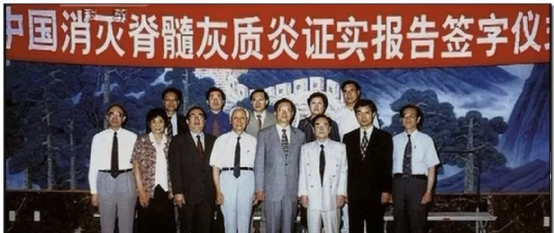
你不害怕被欺辱,是因为我们有像 于敏这样,隐姓埋名为国家核事业开辟道路的科学家。
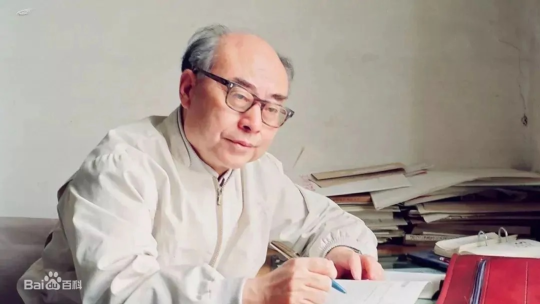
你不害怕饥荒,是因为我们有 将毕生献给水稻事业的袁隆平。

吃着小镇做题家的福利,骂着小镇做题家的出身。
实在无耻。
请记住,你们被优越的环境塑造出来的能力,应该用在正途之上。
而不是为了让你们凌驾于没有享受过同等资源的人们身上,目中无人的。
169. Don't let yesterday use up too much of today. 别留念昨天了,把握好今天吧。(Will Rogers) 170. If you are not brave enough, no one w ill back you up. 你不勇敢,没人替你坚强。171. If you don't build your dream, someone will hire you to build theirs. 如果你没有梦想,那么你只能为别人的梦想打工。172. Beauty is all around, if you 在意的那些结根本算不了什么。183. The key to acquiring proficiency in any task is repetition. 任何事情成功关键都是熟能生巧。《生活大爆炸》 184. You can be happy no matter what. 开心一点吧,管它会怎样。185. A good plan today is better than a perfect plan tomorrow. 今天的好计划胜过明天的完美计划。186. Nothing is impossible, the word itself says 'I'm possible'! 一切皆有可能!“不可能”的意思是:“不,可能。”(奥黛丽·赫本) 187. Life isn't fair, but no matter your circumstances, you have to give it your all. 生活是不公平的,不管你的境遇如何,你只能全力以赴。188. No matter how hard it is, just keep going because you only fail when you give up. 无论多么艰难,都要继续前进,因为只有你放弃的那一刻,你才输了。When Paul Jobs was mustered out of the Coast Guard after World War II, he made a wager with his crewmates. They had arrived in San Francisco, where their ship was decommissioned, and Paul bet that he would find himself a wife within two weeks. He was a taut, tattooed engine mechanic, six feet tall, with a passing resemblance to James Dean. But it wasn’t his looks that got him a date with Clara Hagopian, a sweet-humored daughter of Armenian immigrants. It was the fact that he and his friends had a car, unlike the group she had originally planned to go out with that evening. Ten days later, in March 1946, Paul got engaged to Clara and won his wager. It would turn out to be a happy marriage, one that lasted until death parted them more than forty years later. Paul Reinhold Jobs had been raised on a dairy farm in Germantown, Wisconsin. Even though his father was an alcoholic and sometimes abusive, Paul ended up with a gentle and calm disposition under his leathery exterior. After dropping out of high mechanic until, at age nineteen, he joined the Coast Guard, even though he didn’t know how to swim. He was deployed on the USS General M. C. Meigs and spent much of the war ferrying troops to Italy for General Patton. His talent as a machinist and fireman earned him commendations, but he occasionally found himself in minor trouble and never rose above the rank of seaman. Clara was born in New Jersey, where her parents had landed after fleeing the Turks in Armenia, and they moved to the Mission District of San Francisco when she was a child. She had a secret that she rarely mentioned to anyone: She had been married before, but her husband had been killed in the war. So when she met Paul Jobs on that first date, she was primed to start a new life. Clara, however, loved San Francisco, and in 1952 she convinced her husband to move back there. They got an apartment in the Sunset District facing the Pacific, just south of Golden Gate Park, and he took a job working for a finance company as a “repo man,” picking the locks of cars whose owners hadn’t paid their loans and repossessing them. He also bought, repaired, and sold some of the cars, making a decent enough living in the process. There was, however, something missing in their lives. They wanted children, but Clara had suffered an ectopic pregnancy, in which the fertilized egg was implanted in a fallopian tube rather than the uterus, and she had been unable to have any. So by 1955, after nine years of marriage, they were looking to adopt a child. Like Paul Jobs, Joanne Schieble was from a rural Wisconsin family of German heritage. Her father, Arthur Schieble, had immigrated to the outskirts of Green Bay, where he and his wife owned a mink farm and dabbled successfully in various other businesses, including real estate and photoengraving. He was very strict, especially regarding his daughter’s relationships, and he had strongly disapproved of her first love, an artist who was not a Catholic. Thus it was no surprise that he threatened to cut Joanne off completely when, as a graduate student at the University of Wisconsin, she fell in love with Abdulfattah “John” Jandali, a Muslim teaching assistant from Syria. Jandali was the youngest of nine children in a prominent Syrian family. His father owned oil refineries and multiple other businesses, with large holdings in Damascus and Homs, and at one point pretty much controlled the price of wheat in the region. His mother, he later said, was a “traditional Muslim woman” who was a “conservative, obedient housewife.” Like the Schieble family, the Jandalis put a premium on education. Abdulfattah was sent to a Jesuit boarding school, even though he was Muslim, and he got an undergraduate degree at the American University in Beirut before entering the University of Wisconsin to pursue a doctoral degree in political science. In the summer of 1954, Joanne went with Abdulfattah to Syria. They spent two months in Homs, where she learned from his family to cook Syrian dishes. When they returned to Wisconsin she discovered that she was pregnant. They were both twenty-three, but they decided not to get married. Her father was dying at the time, and he had threatened to disown her if she wed Abdulfattah. Nor was abortion an easy option in a small Catholic community. So in early 1955, Joanne traveled to San Francisco, where she was taken into the care of a kindly doctor who sheltered unwed mothers, delivered their babies, and quietly arranged closed adoptions. Joanne had one requirement: Her child must be adopted by college graduates. So the doctor arranged for the baby to be placed with a lawyer and his wife. But when a boy was born—on February 24, 1955—the designated couple decided that they wanted a girl and backed out. Thus it was that the boy became the son not of a lawyer but of a high school dropout with a passion for mechanics and his salt-of-the-earth wife who was working as a bookkeeper. Paul and Clara named their new baby Steven Paul Jobs. When Joanne found out that her baby had been placed with a couple who had not even graduated from high school, she refused to sign the adoption papers. The standoff lasted weeks, even after the baby had settled into the Jobs household. Eventually Joanne relented, with the stipulation that the couple promise—indeed sign a pledge—to fund a savings account to pay for the boy’s college education. There was another reason that Joanne was balky about signing the adoption papers. Her father was about to die, and she planned to marry Jandali soon after. She held out hope, she would later tell family members, sometimes tearing up at the memory, that once they were married, she could get their 别让梦想只停留在梦里。181. A day without laughter is a day wasted. 没有笑声的一天是浪费了的一天。(卓别林) 182. Travel and see the world; afterwards, you will be able to put your concerns in perspective. 去旅行吧,见的世面多了,你会发现原来在意的那些结根本算不了什么。183. The key to acquiring proficiency in any task is repetition. 任何事情成功关键都是熟能生巧。《生活大爆炸》 184. You can be happy no matter what. 开心一点吧,管它会怎样。baby boy back. Arthur Schieble died in August 1955, after the adoption was finalized. Just after Christmas that year, Joanne and Abdulfattah were married in St. Philip the Apostle Catholic Church in Green Bay. He got his PhD in international politics the next year, and then they had another child, a girl named Mona. After she and Jandali porced in 1962, Joanne embarked on a dreamy and peripatetic life that her daughter, who grew up to become the acclaimed novelist Mona Simpson, would capture in her book Anywhere but Here. Because Steve’s adoption had been closed, it would be twenty years before they would all find each other. Steve Jobs knew from an early age that he was adopted. “My parents were very open with me about that,” he recalled. He had a vivid memory of sitting on the lawn of his house, when he was six or seven years old, telling the girl who lived across the street. “So does that mean your real parents didn’t want you?” the girl asked. “Lightning bolts went off in my head,” according to Jobs. “I remember running into the house, crying. And my parents said, ‘No, you have to understand.’ They were very serious and looked me straight in the eye. They said, ‘We specifically picked you out.’ Both of my parents said that and repeated it slowly for me. And they put an emphasis on every word in that sentence.” Abandoned. Chosen. Special. Those concepts became part of who Jobs was and how he regarded himself. His closest friends think that the knowledge that he was given up at birth left some scars. “I think his desire for complete control of whatever he makes derives directly from his personality and the fact that he was abandoned at birth,” said one longtime colleague, Del Yocam. “He wants to control his environment, and he sees the product as an extension of himself.” Greg Calhoun, who became close to Jobs right after college, saw another effect. “Steve talked to me a lot about being abandoned and the pain that caused,” he said. “It made him independent. He followed the beat of a different drummer, and that came from being in a different world than he was born into.” Later in life, when he was the same age his biological father had been when he abandoned him, Jobs would father and abandon a child of his own. (He eventually took responsibility for her.) Chrisann Brennan, the mother of that child, said that being put up for adoption left Jobs “full of broken glass,” and it helps to explain some of his behavior. “He who is abandoned is an abandoner,” she said. Andy Hertzfeld, who worked with Jobs at Apple in the early 1980s, is among the few who remained close to both Brennan and Jobs. “The key question about Steve is why he can’t control himself at times from being so reflexively cruel and harmful to some people,” he said. “That goes back to being abandoned at birth. The real underlying problem was the theme of abandonment in Steve’s life.” Jobs dismissed this. “There’s some notion that because I was abandoned, I worked very hard so I could do well and make my parents wish they had me back, or some such nonsense, but that’s ridiculous,” he insisted. “Knowing I was adopted may have made me feel more independent, but I have never felt abandoned. I’ve always felt special. My parents made me feel special.” He would later bristle whenever anyone referred to Paul and Clara Jobs as his “adoptive” parents or implied that they were not his “real” parents. “They were my parents 1,000%,” he said. When speaking about his biological parents, on the other hand, he was curt: “They were my sperm and egg bank. That’s not harsh, it’s just the way it was, a sperm bank thing, nothing more.” Silicon Valley The childhood that Paul and Clara Jobs created for their new son was, in many ways, a stereotype of the late 1950s. When Steve was two they adopted a girl they named Patty, and three years later they moved to a tract house in the suburbs. The finance company where Paul worked as a repo man, CIT, had transferred him down to its Palo Alto office, but he could not afford to live there, so they landed in a subpision in Mountain View, a less expensive town just to the south. There Paul tried to pass along his love of mechanics and cars. “Steve, this is your workbench now,” he said as he marked off a section of the table in their garage. Jobs remembered being impressed by his father’s focus on craftsmanship. “I thought my dad’s sense of design was pretty good,” he said, “because he knew how to build anything. If we needed a cabinet, he would build it. When he built our fence, he gave me a hammer so I could work with him.” Fifty years later the fence still surrounds the back and side yards of the house in Mountain View. As Jobs showed it off to me, he caressed the stockade panels and recalled a lesson that his father implanted deeply in him. It was important, his father said, to craft the backs of cabinets and fences properly, even though they were hidden. “He loved doing things right. He even cared about the look of the parts you couldn’t see.” His father continued to refurbish and resell used cars, and he festooned the garage with pictures of his favorites. He would point out the detailing of the design to his son: the lines, the vents, the chrome, the trim of the seats. After work each day, he would change into his dungarees and retreat to the garage, often with Steve tagging along. “I figured I could get him nailed down with a little mechanical ability, but he really wasn’t interested in getting his hands dirty,” Paul later recalled. “He never really cared too much about m189. It requires hard work to give off an appearance of effortlessness. 你必须十分努力,才能看起来毫不费力。190. Life is like riding a bicycle.To keep your balance,you must keep moving. 人生就像骑单车,只有不断前进,才能保持平衡。(爱因斯坦) 191. Be thankful for what you have.You'll end up having more. 拥有一颗感恩的心,最终你会得到更多。192. Beauty is how you feel inside, and it reflects in your eyes. 美是一种内心的感觉,并反映在你的眼睛里。(索菲亚·罗兰) 193. Friendship doubles your joys, and pides your sorrows. 朋友的作用,就是让你快乐加倍,痛苦减半。194. When you long for something sincerely, the whole world will help you. 当你真心渴望某样东西时,整个宇宙都会来帮忙。echanical things.” “I wasn’t that into fixing cars,” Jobs admitted. “But I was eager to hang out with my dad.” Even as he was growing more aware that he had been adopted, he was becoming more attached to his father. One day when he was about eight, he discovered a photograph of his father from his time in the Coast Guard. “He’s in the engine room, and he’s got his shirt off and looks like James Dean. It was one of those Oh wow moments for a kid. Wow, oooh, my parents were actually once very young and really good-looking.” Through cars, his father gave Steve his first exposure to electronics. “My dad did not have a deep understanding of electronics, but he’d encountered it a lot in automobiles and other things he would fix. He showed me the rudiments of electronics, and I got very interested in that.” Even more interesting were the trips to scavenge for parts. “Every weekend, there’d be a junkyard trip. We’d be looking for a generator, a carburetor, all sorts of components.” He remembered watching his father negotiate at the counter. “He was a good bargainer, because he knew better than the guys at the counter what the parts should cost.” This helped fulfill the pledge his parents made when he was adopted. “My college fund came from my dad paying $50 for a Ford Falcon or some other beat-up car that didn’t run, working on it for a few weeks, and selling it for $250—and not telling the IRS.” The Jobses’ house and the others in their neighborhood were built by the real estate developer Joseph Eichler, whose company spawned more than eleven thousand homes in various California subpisions between 1950 and 1974. Inspired by Frank Lloyd Wright’s vision of simple modern homes for the American “everyman,” Eichler built inexpensive houses that featured floor-to-ceiling glass walls, open floor plans, exposed post-and-beam construction, concrete slab floors, and lots of sliding glass doors. “Eichler did a great thing,” Jobs said on one of our walks around the neighborhood. “His houses were smart and cheap and good. They brought clean design and simple taste to lower-income people. They had awesome little features, like radiant heating in the floors. You put carpet on them, and we had nice toasty floors when we were kids.” Jobs said that his appreciation for Eichler homes instilled in him a passion for making nicely designed products for the mass market. “I love it when you can bring really great design and simple capability to something that doesn’t cost much,” he said as he pointed out the clean elegance of the houses. “It was the original vision for Apple. That’s what we tried to do with the first Mac. That’s what we did with the iPod.” Across the street from the Jobs family lived a man who had become successful as a real estate agent. “He wasn’t that bright,” Jobs recalled, “but he seemed to be making a fortune. So my dad thought, ‘I can do that.’ He worked so hard, I remember. He took these night classes, passed the license test, and got into real estate. Then the bottom fell out of the market.” As a result, the family found itself financially strapped for a year or so while Steve was in elementary school. His mother took a job as a bookkeeper for Varian Associates, a company that made scientific instruments, and they took out a second mortgage. One day his fourth-grade teacher asked him, “What is it you don’t understand about the universe?” Jobs replied, “I don’t understand why all of a sudden my dad is so broke.” He was proud that his father never adopted a servile attitude or slick style that may have made him a better salesman. “You had to suck up to people to sell real estate, and he wasn’t good at that and it wasn’t in his nature. I admired him for that.” Paul Jobs went back to being a mechanic. His father was calm and gentle, traits that his son later praised more than emulated. He was also resolute. Jobs described one exampl What made the neighborhood different from the thousands of other spindly-tree subpisions across America was that even the ne’er-do-wells tended to be engineers. “When we moved here, there were apricot and plum orchards on all of these corners,” Jobs recalled. “But it was beginning to boom because of military investment.” He soaked up the history of the valley and developed a yearning to play his own role. Edwin Land of Polaroid later told him about being asked by Eisenhower to help build the U-2 spy plane cameras to see how real the Soviet threat was. The film was dropped in canisters and returned to the NASA Ames Research Center in Sunnyvale, not far from where Jobs lived. “The first computer terminal I ever saw was when my dad brought me to the Ames Center,” he said. “I fell totally in love with it.” Other defense contractors sprouted nearby during the 1950s. The Lockheed Missiles and Space Division, which built submarine-launched ballistic missiles, was founded in 1956 next to the NASA Center; by the time Jobs moved to the area four years later, it employed twenty thousand people. A few hundred yards away, Westinghouse built facilities that produced tubes and electrical transformers for the missile systems. “You had all these military companies on the cutting edge,” he recalled. “It was mysterious and high-tech and made living here very exciting.” In the wake of the defense industries there arose a booming economy based on technology. Its roots stretched back to 1938, when David Packard and his new wife moved into a house in Palo Alto that had a shed where his friend Bill Hewlett was soon ensconced. The house had a garage—an appendage that would prove both useful and iconic in the valley—in which they tinkered around until they had their first product, an audio oscillator. By the 1950s, Hewlett-Packard was a fast-growing company making technical instruments. Fortunately there was a place nearby for entrepreneurs who had outgrown their garages. In a move that would help transform the area into the cradle of the tech revolution, Stanford University’s dean of engineering, Frederick Terman, created a seven-hundred-acre industrial park on university land for private companies that could commercialize the ideas of his students. Its first tenant was Varian Associates, where Clara Jobs worked. “Terman came up with this great idea that did more than anything to cause the tech industry to grow up here,” Jobs said. By the time Jobs was ten, HP had nine thousand employees and was the blue-chip company where every engineer seeking financial stability wanted to work. The most important technology for the region’s growth was, of course, the semiconductor. William Shockley, who had been one of the inventors of the transistor at Bell Labs in New Jersey, moved out to Mountain View and, in 1956, started a company to build transistors using silicon rather than the more expensive germanium that was then commonly used. But Shockley became increasingly erratic and abandoned his silicon transistor project, which led eight of his engineers—most notably Robert Noyce and Gordon Moore—to break away to form Fairchild Semiconductor. That company grew to twelve thousand employees, but it fragmented in 1968, when Noyce lost a power struggle to become CEO. He took Gordon Moore and founded a company that they called Integrated Electronics Corporation, which they soon smartly abbreviated to Intel. Their third employee was Andrew Grove, who later would grow the company by shifting its focus from memory chips to microprocessors. Within a few years there would be more than fifty companies in the area making semiconductors. The exponential growth of this industry was correlated with the phenomenon famously discovered by Moore, who in 1965 drew a graph of the speed of integrated circuits, based on the number of transistors that could be placed on a chip, and showed that it doubled about every two years, a trajectory that could be expected to continue. This was reaffirmed in 1971, when Intel was able to etch a complete central processing unit onto one chip, the Intel 4004, tronic amplifier. “So I raced home, and I told my dad that he was wrong.” “No, it needs an amplifier,” his father assured him. When Steve protested otherwise, his father said he was crazy. “It can’t work without an amplifier. There’s some trick.” “I kept saying no to my dad, telling him he had to see it, and finally he actually walked down with me and saw it. And he said, ‘Well I’ll be a bat out of hell.’” Jobs recalled the incident vividly because it was his first realization that his father did not know everything. Then a more disconcerting discovery began to dawn on him: He was smarter than his parents. He had always admired his father’s competence and savvy. “He was not an educated man, but I had always thought he was pretty damn smart. He didn’t read much, but he could do a lot. Almost everything mechanical, he could figure it out.” Yet the carbon microphone incident, Jobs said, began a jarring process of realizing that he was in fact more clever and quick than his parents. “It was a very big moment that’s burned into my mind. When I realized that I was smarter than my parents, I felt tremendous shame for having thought that. I will never forget that moment.” This discovery, he later told friends, along with the fact that he was adopted, made him feel apart—detached and separate—from both his family and the world. Another layer of awareness occurred soon after. Not only did he discover that he was brighter than his parents, but he discovered that they knew this. Paul and Clara Jobs were loving parents, and they were willing to adapt their lives to suit a son who was very smart—and also willful. They would go to great lengths to accommodate him. And soon Steve discovered this fact as well. “Both my parents got me. They felt a lot of responsibility once they sensed that I was special. They found ways to keep feeding me stuff and putting me in better schools. They were willing to defer to my needs.” So he grew up not only with a sense of having once been abandoned, but also with a sense that he was special. In his own mind, that was more important in the formation of his personality. School Even before Jobs started elementary school, his mother had taught him how to read. This, however, led to some problems once he got to school. “I was kind of bored for the first few years 在这种情况下,俄罗斯和欧洲正兴建一条新的天然气运输管道,这就是北溪-2项目,这个项目全长1224公里,从俄罗斯穿过波罗的海,将天然气运输到德国和其它国家,欧洲很多国家都参与了这条管道项目的建设,毕竟这是欧洲国家的民生工程。一旦这条管道建设完成,可以为欧洲提供每年330亿立方米的天然气,可以满足欧洲对天然气十分之一的需求,这可是非常大的。它是气态行星没有实体表面,由90%的氢和10%的氦(原子数之比, 75/25%的质量比)及微量的甲烷、水、氨水和“石头”组成。这与形成整个太阳系的原始的太阳系星云的组成十分相似。木星可能有一个石质的内核,相当于10-15个地球的质量。内核上则是大部分的行星物质集结地,以液态氢的形式存在。液态金属氢由离子化的质子与电子组成(类似于太阳的内部,不过温度低多了)。木星共有67颗木卫。按距离木星中心由近及远的次序为:木卫十六、木卫十四、木卫五、木卫十五、木卫一、木卫二、木卫三、木卫四、木卫十三、木卫六、木卫十、木卫七、木卫十二、木卫十一、木卫八和木卫九。[46] 水星是最接近太阳的行星。水星的半径约为2440公里,在八大行星中是最小的。水星昼夜温差极大,白天摄氏 430 度,晚上约可达零下170 度,是太阳系八大行星中温差最大的一个行星。[47] 水星的外大气层非常稀薄,是由水星表面和太阳风中的原子和离子构成。[48] 科学家确认水星表面含有丰富的碳,认为碳是水星表面呈黑色的原因,水星表面的岩石是由低重量百分比的石墨碳构成。[49] “好奇号”火星探测器在火星表面采集样本 “好奇号”火星探测器在火星表面采集样本 [50] 火星是地球的近邻,是太阳系由内往外数第四颗行星。直径6794km,体积为地球的15%,质量为地球的11%。火星表面是一个荒凉的世界,空气中二氧化碳占了95%。火星大气十分稀薄,密度还不到地球大气的1%,因而根本无法保存热量。这导致火星表面温度极低,很少超过0℃,在夜晚,最低温度则可达到-123℃。火星被称为红色的行星,这是因为它表面布满了氧化物,因而呈现出铁锈红色。其表面的大部分地区都是含有大量的红色氧化物的大沙漠,还有赭色的砾石地和凝固的熔岩流。火星上常常有猛烈的大风,大风扬起沙尘能形成可以覆盖火星全球的特大型沙尘暴。每次沙尘暴可持续数个星期。火星两极的冰冠和火星大气中含有水份。从火星表面获得的探测数据证明,在远古时期八颗行星,直径49532千米。海王星绕太阳运转的轨道半径为45亿千米,公转一周需要165年。海王星的直径和天王星类似,质量比天王星略大一些。海王星和天王星的主要大气成分都是氢和氦,内部结构也极为相近,所以说海王星与天王星是一对孪生兄弟。[55] 海王星有太阳系最强烈的风,测量到的时速高达2100公里。海王星云顶的温度是-218 °C,是太阳系最冷的地区之一。海王星核心的温度约为7000 °C,可以和太阳的表面比较。海王星在1846年9月23日被发现,是唯一利用数学预测而非有计划的观测发现的行星。[56] 冥王星,位于海王星以外的柯伊伯带内侧,是柯伊伯带中已知的最大天体。[57] 直径约为2370±20km,是地球直径的18.5%。[58] 2006年8月24日,国际天文学联合会大会24日投票决定,不再将传统九大行星之一的冥王星视为行星,而将其列入“矮行星”。大会通过的决议规定,“行星”指的是围绕太阳运转、自身引力足以克服其刚体力而使天体呈圆球状、能够清除其轨道附近其他物体的天体。在太阳系传统的“九大行星”中,只有水星、金星、地球、火星、木星、土星、天王星和海王星符合这些要求。冥王星由于其轨道与海王星的轨道相交,不符合新的行星定义,因此被自动降级为“矮行星”。[59] 冥王星的表面温度大概在-238到-228℃之间。冥王星的成份由70%岩石和30%冰水混合而成的。地表上光亮的部分可能覆盖着一些固体氮以及少量 卫星拍月球经过地球,可见清晰月球背面 卫星拍月球经过地球,可见清晰月球背面 [60] 的固体甲烷和一氧化碳,冥王星表面的黑暗部分可能是一些基本的有机物质或是由宇宙射线引发的光化学反应。冥王星的大气层主要由氮和少量的一氧化碳及甲烷组成。大气极其稀薄,地面压强只有少量微帕。[61] 地球是离太阳第三颗行星,是我们人类的家乡,尽管地球是太阳系中一颗普通的行星,但它在许多方面都是独一无二的。比如,它是太阳系中唯一一颗面积大部分被水覆盖的行星,也是目前所知唯一一颗有生命存在的星球。质量M=5.9742 ×10^24 公斤,表面温度:t = - 30 ~ +45。[62] 英国科研人员在《天体生物学》杂志上报告说,如果没有小行星撞击等可能剧烈改变环境的事件发生,地球适宜人类居住的时间还剩约17.5亿年,不过人为造成的气候变化可能缩短这一时间。[63] 彗星是由灰尘和冰块组成的太阳系中的一类小天体,绕日运动。[64] 科学家使用探测器对彗星的化学遗留物进行分析,发现其主要成份为氨、甲烷、硫化氢、氰化氢和甲醛。科学家得出结论称,彗星的气味闻起来像是臭鸡蛋、马尿、酒精和苦杏仁的气味综合。[65-66] “67P/楚留莫夫-格拉希门克”彗星 “67P/楚留莫夫-格拉希门克”彗星 [67] 在太阳系的周围还包裹着一个庞大的“奥尔特云”。星云内分布着不计其数的冰块、雪团和碎石。其中的某些会受太阳引力影响飞入内太阳系,这学说,在原有的轨道(或称小天体轨道)上又增加了更多的天体运行轨道。这一模式称每颗行星都沿着一个小轨道作圆周运行,而小轨道又沿着该行星的大轨道绕地球作圆周运动。几百年之后,这一模式的漏洞越来越明显。科学家们又在这个模式上增加了许多轨道,行星就这样沿着一道又一道的轨道作圆周运动。哥白尼想用“现代”(16世纪的)技术来改进托勒密的测量结果,以期取消一些小轨道。在长达近20年的时间里,哥白尼不辞辛劳日夜测量行星的位置,但其测量获得的结果仍然与托勒密的天体运行模式没有多少差别。哥白尼想知道在另一个运行着的行星上观察这些行星的运行情况会是什么样的。基于这种设想,哥白尼萌发了一个念头:假如地球在运行中,那么这些行星的运行看上去会是什么情况呢?这一设想在他脑海里变得清晰起来了。一年里,哥白尼在不同的时间、不同的距离从地球上观察行星,每一个行星的情况都不相同,这是他意识到地球不可能位于星星轨道的中心。经过20年的观测,哥白尼发现唯独太阳的周年变化不明显。这意味着地球和太阳的距离始终没有改变。如果地球不是宇宙的中心,那么宇宙的中心就是太阳。的发现才使牛顿有能力确定运动定律和万有引力定律。哥白尼的日心宇宙体系既然是时代的产物,它就不能不受到时代的限制。反对神学的不彻底性,同时表现在哥白尼的某些观点上,他的体系是存在缺陷的。哥白尼所指的宇宙是局限在一个小的范围内的,具体来说,他的宇宙结构就是今天我们所熟知的太阳系,即以太阳为中心的天体系统。宇宙既然有它的中心,就必须有它的边界,哥白尼虽然否定了托勒玫的“九重天”,但他却保留了一层恒星天,尽管他回避了宇宙是否有限这个问题,但实际上他是相信恒星天球是宇宙的“外壳”,他仍然相信天体只能按照所谓完美的圆形轨道运动,所以哥白尼的宇宙体系,仍然包含着不动的中心天体。但是作为近代自然科学的奠基人,哥白尼的历史功绩是伟大的。确认地球不是宇宙的中心,而是行星之一,从而掀起了一场天文学上根本性的革命,是人类探求客观真理道路上的里程碑。哥白尼的伟大成就,不仅铺平了通向近代天文学的道路,而且开创了整个自然界科学向前迈进的新时代。从哥白尼时代起,脱离教会束缚的自然科学和哲学开始获得飞跃的发展。哥白尼的科学成就,是他所处时代的产物,又转过来推动了时代的发展。顺应时代变化 十五、六世纪的欧洲,正是从封建社会向资本主义社会转变的关键时期,在这一二百年间,社会发生了巨大的变化。14世纪以前的欧洲,到处是四分五裂的小城邦。后来,随着城市工商业的兴起,特别是采矿和冶金业的发展,涌现了许多新兴的大城市,小城邦有了联合起来组成国家的趋势。到 15世纪末叶,在许多国家里都出现了基本上是中央集权的君主政体。当时的波兰不仅有像克拉科夫、波兹南这样的大城市,也有许多手工业兴盛的城
5
曾经,我也是一个小镇做题家。
我出身于湖南的一个并不怎么发达的小镇。
镇上只有一个中学,还是几个破败不堪的平房构成的。
湖南的夏天很热,太阳晒得人直发晕。
汗水止不住地滴,常常会晕开课本上的字迹。
冬天,又是长达好几个月的湿冷。
我手上总是长满了冻疮,翻开书页都觉得疼。
但我知道,只要我肯读书,肯下功夫,总会离开这里。
后来,我考上了985,也有了一份不错的工作。
回头再看那些咬牙走过来的时光。
我想不感谢那浩如烟海的题册,但我感谢坚持走完全程的自己。
即便现在被人嘲讽是小镇做题家。
但我清楚地明白,正是这份逆境下的坚韧,成全了如今的我。
努力,终究会让平凡人变得耀眼。
不管别人怎么说,我始终相信,在泥泞中摸爬滚打走过来的人,终有出路。
即便我们的人生没有那么多花团锦簇。
但那一步一步走过来的脚印,都是我们不向生活低头的军功章。
每一个凭借自己努力,打拼出一番天地来的普通人,都无比荣耀。
我们或许未曾拥有过漫天星辰。
也搭不上那辆人生快车。
但纵然卑微,纵然渺小。
我们也都是能够为自己指路的明灯。
小镇做题家怎么了?
堂堂正正地参加考试,获得工作,总比拼爹拼妈拼户口来得光荣。
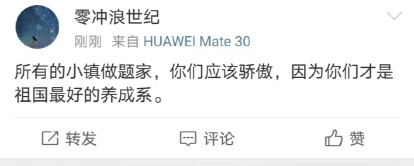
青年们,千万不要被这些偏见击倒。
不要去听从外界强加给你的标签。
不要屈从既定的社会结构。
我们应该像灯一样。
哪怕会为风、虫之类的外在影响所遮蔽。
也可以清纯地、透明地、热烈的燃烧着。
169. Don't let yesterday use up too much of today. 别留念昨天了,把握好今天吧。(Will Rogers) 170. If you are not brave enough, no one w ill back you up. 你不勇敢,没人替你坚强。171. If you don't build your dream, someone will hire you to build theirs. 如果你没有梦想,那么你只能为别人的梦想打工。172. Beauty is all around, if you 在意的那些结根本算不了什么。183. The key to acquiring proficiency in any task is repetition. 任何事情成功关键都是熟能生巧。《生活大爆炸》 184. You can be happy no matter what. 开心一点吧,管它会怎样。185. A good plan today is better than a perfect plan tomorrow. 今天的好计划胜过明天的完美计划。186. Nothing is impossible, the word itself says 'I'm possible'! 一切皆有可能!“不可能”的意思是:“不,可能。”(奥黛丽·赫本) 187. Life isn't fair, but no matter your circumstances, you have to give it your all. 生活是不公平的,不管你的境遇如何,你只能全力以赴。188. No matter how hard it is, just keep going because you only fail when you give up. 无论多么艰难,都要继续前进,因为只有你放弃的那一刻,你才输了。When Paul Jobs was mustered out of the Coast Guard after World War II, he made a wager with his crewmates. They had arrived in San Francisco, where their ship was decommissioned, and Paul bet that he would find himself a wife within two weeks. He was a taut, tattooed engine mechanic, six feet tall, with a passing resemblance to James Dean. But it wasn’t his looks that got him a date with Clara Hagopian, a sweet-humored daughter of Armenian immigrants. It was the fact that he and his friends had a car, unlike the group she had originally planned to go out with that evening. Ten days later, in March 1946, Paul got engaged to Clara and won his wager. It would turn out to be a happy marriage, one that lasted until death parted them more than forty years later. Paul Reinhold Jobs had been raised on a dairy farm in Germantown, Wisconsin. Even though his father was an alcoholic and sometimes abusive, Paul ended up with a gentle and calm disposition under his leathery exterior. After dropping out of high mechanic until, at age nineteen, he joined the Coast Guard, even though he didn’t know how to swim. He was deployed on the USS General M. C. Meigs and spent much of the war ferrying troops to Italy for General Patton. His talent as a machinist and fireman earned him commendations, but he occasionally found himself in minor trouble and never rose above the rank of seaman. Clara was born in New Jersey, where her parents had landed after fleeing the Turks in Armenia, and they moved to the Mission District of San Francisco when she was a child. She had a secret that she rarely mentioned to anyone: She had been married before, but her husband had been killed in the war. So when she met Paul Jobs on that first date, she was primed to start a new life. Clara, however, loved San Francisco, and in 1952 she convinced her husband to move back there. They got an apartment in the Sunset District facing the Pacific, just south of Golden Gate Park, and he took a job working for a finance company as a “repo man,” picking the locks of cars whose owners hadn’t paid their loans and repossessing them. He also bought, repaired, and sold some of the cars, making a decent enough living in the process. There was, however, something missing in their lives. They wanted children, but Clara had suffered an ectopic pregnancy, in which the fertilized egg was implanted in a fallopian tube rather than the uterus, and she had been unable to have any. So by 1955, after nine years of marriage, they were looking to adopt a child. Like Paul Jobs, Joanne Schieble was from a rural Wisconsin family of German heritage. Her father, Arthur Schieble, had immigrated to the outskirts of Green Bay, where he and his wife owned a mink farm and dabbled successfully in various other businesses, including real estate and photoengraving. He was very strict, especially regarding his daughter’s relationships, and he had strongly disapproved of her first love, an artist who was not a Catholic. Thus it was no surprise that he threatened to cut Joanne off completely when, as a graduate student at the University of Wisconsin, she fell in love with Abdulfattah “John” Jandali, a Muslim teaching assistant from Syria. Jandali was the youngest of nine children in a prominent Syrian family. His father owned oil refineries and multiple other businesses, with large holdings in Damascus and Homs, and at one point pretty much controlled the price of wheat in the region. His mother, he later said, was a “traditional Muslim woman” who was a “conservative, obedient housewife.” Like the Schieble family, the Jandalis put a premium on education. Abdulfattah was sent to a Jesuit boarding school, even though he was Muslim, and he got an undergraduate degree at the American University in Beirut before entering the University of Wisconsin to pursue a doctoral degree in political science. In the summer of 1954, Joanne went with Abdulfattah to Syria. They spent two months in Homs, where she learned from his family to cook Syrian dishes. When they returned to Wisconsin she discovered that she was pregnant. They were both twenty-three, but they decided not to get married. Her father was dying at the time, and he had threatened to disown her if she wed Abdulfattah. Nor was abortion an easy option in a small Catholic community. So in early 1955, Joanne traveled to San Francisco, where she was taken into the care of a kindly doctor who sheltered unwed mothers, delivered their babies, and quietly arranged closed adoptions. Joanne had one requirement: Her child must be adopted by college graduates. So the doctor arranged for the baby to be placed with a lawyer and his wife. But when a boy was born—on February 24, 1955—the designated couple decided that they wanted a girl and backed out. Thus it was that the boy became the son not of a lawyer but of a high school dropout with a passion for mechanics and his salt-of-the-earth wife who was working as a bookkeeper. Paul and Clara named their new baby Steven Paul Jobs. When Joanne found out that her baby had been placed with a couple who had not even graduated from high school, she refused to sign the adoption papers. The standoff lasted weeks, even after the baby had settled into the Jobs household. Eventually Joanne relented, with the stipulation that the couple promise—indeed sign a pledge—to fund a savings account to pay for the boy’s college education. There was another reason that Joanne was balky about signing the adoption papers. Her father was about to die, and she planned to marry Jandali soon after. She held out hope, she would later tell family members, sometimes tearing up at the memory, that once they were married, she could get their 别让梦想只停留在梦里。181. A day without laughter is a day wasted. 没有笑声的一天是浪费了的一天。(卓别林) 182. Travel and see the world; afterwards, you will be able to put your concerns in perspective. 去旅行吧,见的世面多了,你会发现原来在意的那些结根本算不了什么。183. The key to acquiring proficiency in any task is repetition. 任何事情成功关键都是熟能生巧。《生活大爆炸》 184. You can be happy no matter what. 开心一点吧,管它会怎样。baby boy back. Arthur Schieble died in August 1955, after the adoption was finalized. Just after Christmas that year, Joanne and Abdulfattah were married in St. Philip the Apostle Catholic Church in Green Bay. He got his PhD in international politics the next year, and then they had another child, a girl named Mona. After she and Jandali porced in 1962, Joanne embarked on a dreamy and peripatetic life that her daughter, who grew up to become the acclaimed novelist Mona Simpson, would capture in her book Anywhere but Here. Because Steve’s adoption had been closed, it would be twenty years before they would all find each other. Steve Jobs knew from an early age that he was adopted. “My parents were very open with me about that,” he recalled. He had a vivid memory of sitting on the lawn of his house, when he was six or seven years old, telling the girl who lived across the street. “So does that mean your real parents didn’t want you?” the girl asked. “Lightning bolts went off in my head,” according to Jobs. “I remember running into the house, crying. And my parents said, ‘No, you have to understand.’ They were very serious and looked me straight in the eye. They said, ‘We specifically picked you out.’ Both of my parents said that and repeated it slowly for me. And they put an emphasis on every word in that sentence.” Abandoned. Chosen. Special. Those concepts became part of who Jobs was and how he regarded himself. His closest friends think that the knowledge that he was given up at birth left some scars. “I think his desire for complete control of whatever he makes derives directly from his personality and the fact that he was abandoned at birth,” said one longtime colleague, Del Yocam. “He wants to control his environment, and he sees the product as an extension of himself.” Greg Calhoun, who became close to Jobs right after college, saw another effect. “Steve talked to me a lot about being abandoned and the pain that caused,” he said. “It made him independent. He followed the beat of a different drummer, and that came from being in a different world than he was born into.” Later in life, when he was the same age his biological father had been when he abandoned him, Jobs would father and abandon a child of his own. (He eventually took responsibility for her.) Chrisann Brennan, the mother of that child, said that being put up for adoption left Jobs “full of broken glass,” and it helps to explain some of his behavior. “He who is abandoned is an abandoner,” she said. Andy Hertzfeld, who worked with Jobs at Apple in the early 1980s, is among the few who remained close to both Brennan and Jobs. “The key question about Steve is why he can’t control himself at times from being so reflexively cruel and harmful to some people,” he said. “That goes back to being abandoned at birth. The real underlying problem was the theme of abandonment in Steve’s life.” Jobs dismissed this. “There’s some notion that because I was abandoned, I worked very hard so I could do well and make my parents wish they had me back, or some such nonsense, but that’s ridiculous,” he insisted. “Knowing I was adopted may have made me feel more independent, but I have never felt abandoned. I’ve always felt special. My parents made me feel special.” He would later bristle whenever anyone referred to Paul and Clara Jobs as his “adoptive” parents or implied that they were not his “real” parents. “They were my parents 1,000%,” he said. When speaking about his biological parents, on the other hand, he was curt: “They were my sperm and egg bank. That’s not harsh, it’s just the way it was, a sperm bank thing, nothing more.” Silicon Valley The childhood that Paul and Clara Jobs created for their new son was, in many ways, a stereotype of the late 1950s. When Steve was two they adopted a girl they named Patty, and three years later they moved to a tract house in the suburbs. The finance company where Paul worked as a repo man, CIT, had transferred him down to its Palo Alto office, but he could not afford to live there, so they landed in a subpision in Mountain View, a less expensive town just to the south. There Paul tried to pass along his love of mechanics and cars. “Steve, this is your workbench now,” he said as he marked off a section of the table in their garage. Jobs remembered being impressed by his father’s focus on craftsmanship. “I thought my dad’s sense of design was pretty good,” he said, “because he knew how to build anything. If we needed a cabinet, he would build it. When he built our fence, he gave me a hammer so I could work with him.” Fifty years later the fence still surrounds the back and side yards of the house in Mountain View. As Jobs showed it off to me, he caressed the stockade panels and recalled a lesson that his father implanted deeply in him. It was important, his father said, to craft the backs of cabinets and fences properly, even though they were hidden. “He loved doing things right. He even cared about the look of the parts you couldn’t see.” His father continued to refurbish and resell used cars, and he festooned the garage with pictures of his favorites. He would point out the detailing of the design to his son: the lines, the vents, the chrome, the trim of the seats. After work each day, he would change into his dungarees and retreat to the garage, often with Steve tagging along. “I figured I could get him nailed down with a little mechanical ability, but he really wasn’t interested in getting his hands dirty,” Paul later recalled. “He never really cared too much about m189. It requires hard work to give off an appearance of effortlessness. 你必须十分努力,才能看起来毫不费力。190. Life is like riding a bicycle.To keep your balance,you must keep moving. 人生就像骑单车,只有不断前进,才能保持平衡。(爱因斯坦) 191. Be thankful for what you have.You'll end up having more. 拥有一颗感恩的心,最终你会得到更多。192. Beauty is how you feel inside, and it reflects in your eyes. 美是一种内心的感觉,并反映在你的眼睛里。(索菲亚·罗兰) 193. Friendship doubles your joys, and pides your sorrows. 朋友的作用,就是让你快乐加倍,痛苦减半。194. When you long for something sincerely, the whole world will help you. 当你真心渴望某样东西时,整个宇宙都会来帮忙。echanical things.” “I wasn’t that into fixing cars,” Jobs admitted. “But I was eager to hang out with my dad.” Even as he was growing more aware that he had been adopted, he was becoming more attached to his father. One day when he was about eight, he discovered a photograph of his father from his time in the Coast Guard. “He’s in the engine room, and he’s got his shirt off and looks like James Dean. It was one of those Oh wow moments for a kid. Wow, oooh, my parents were actually once very young and really good-looking.” Through cars, his father gave Steve his first exposure to electronics. “My dad did not have a deep understanding of electronics, but he’d encountered it a lot in automobiles and other things he would fix. He showed me the rudiments of electronics, and I got very interested in that.” Even more interesting were the trips to scavenge for parts. “Every weekend, there’d be a junkyard trip. We’d be looking for a generator, a carburetor, all sorts of components.” He remembered watching his father negotiate at the counter. “He was a good bargainer, because he knew better than the guys at the counter what the parts should cost.” This helped fulfill the pledge his parents made when he was adopted. “My college fund came from my dad paying $50 for a Ford Falcon or some other beat-up car that didn’t run, working on it for a few weeks, and selling it for $250—and not telling the IRS.” The Jobses’ house and the others in their neighborhood were built by the real estate developer Joseph Eichler, whose company spawned more than eleven thousand homes in various California subpisions between 1950 and 1974. Inspired by Frank Lloyd Wright’s vision of simple modern homes for the American “everyman,” Eichler built inexpensive houses that featured floor-to-ceiling glass walls, open floor plans, exposed post-and-beam construction, concrete slab floors, and lots of sliding glass doors. “Eichler did a great thing,” Jobs said on one of our walks around the neighborhood. “His houses were smart and cheap and good. They brought clean design and simple taste to lower-income people. They had awesome little features, like radiant heating in the floors. You put carpet on them, and we had nice toasty floors when we were kids.” Jobs said that his appreciation for Eichler homes instilled in him a passion for making nicely designed products for the mass market. “I love it when you can bring really great design and simple capability to something that doesn’t cost much,” he said as he pointed out the clean elegance of the houses. “It was the original vision for Apple. That’s what we tried to do with the first Mac. That’s what we did with the iPod.” Across the street from the Jobs family lived a man who had become successful as a real estate agent. “He wasn’t that bright,” Jobs recalled, “but he seemed to be making a fortune. So my dad thought, ‘I can do that.’ He worked so hard, I remember. He took these night classes, passed the license test, and got into real estate. Then the bottom fell out of the market.” As a result, the family found itself financially strapped for a year or so while Steve was in elementary school. His mother took a job as a bookkeeper for Varian Associates, a company that made scientific instruments, and they took out a second mortgage. One day his fourth-grade teacher asked him, “What is it you don’t understand about the universe?” Jobs replied, “I don’t understand why all of a sudden my dad is so broke.” He was proud that his father never adopted a servile attitude or slick style that may have made him a better salesman. “You had to suck up to people to sell real estate, and he wasn’t good at that and it wasn’t in his nature. I admired him for that.” Paul Jobs went back to being a mechanic. His father was calm and gentle, traits that his son later praised more than emulated. He was also resolute. Jobs described one exampl What made the neighborhood different from the thousands of other spindly-tree subpisions across America was that even the ne’er-do-wells tended to be engineers. “When we moved here, there were apricot and plum orchards on all of these corners,” Jobs recalled. “But it was beginning to boom because of military investment.” He soaked up the history of the valley and developed a yearning to play his own role. Edwin Land of Polaroid later told him about being asked by Eisenhower to help build the U-2 spy plane cameras to see how real the Soviet threat was. The film was dropped in canisters and returned to the NASA Ames Research Center in Sunnyvale, not far from where Jobs lived. “The first computer terminal I ever saw was when my dad brought me to the Ames Center,” he said. “I fell totally in love with it.” Other defense contractors sprouted nearby during the 1950s. The Lockheed Missiles and Space Division, which built submarine-launched ballistic missiles, was founded in 1956 next to the NASA Center; by the time Jobs moved to the area four years later, it employed twenty thousand people. A few hundred yards away, Westinghouse built facilities that produced tubes and electrical transformers for the missile systems. “You had all these military companies on the cutting edge,” he recalled. “It was mysterious and high-tech and made living here very exciting.” In the wake of the defense industries there arose a booming economy based on technology. Its roots stretched back to 1938, when David Packard and his new wife moved into a house in Palo Alto that had a shed where his friend Bill Hewlett was soon ensconced. The house had a garage—an appendage that would prove both useful and iconic in the valley—in which they tinkered around until they had their first product, an audio oscillator. By the 1950s, Hewlett-Packard was a fast-growing company making technical instruments. Fortunately there was a place nearby for entrepreneurs who had outgrown their garages. In a move that would help transform the area into the cradle of the tech revolution, Stanford University’s dean of engineering, Frederick Terman, created a seven-hundred-acre industrial park on university land for private companies that could commercialize the ideas of his students. Its first tenant was Varian Associates, where Clara Jobs worked. “Terman came up with this great idea that did more than anything to cause the tech industry to grow up here,” Jobs said. By the time Jobs was ten, HP had nine thousand employees and was the blue-chip company where every engineer seeking financial stability wanted to work. The most important technology for the region’s growth was, of course, the semiconductor. William Shockley, who had been one of the inventors of the transistor at Bell Labs in New Jersey, moved out to Mountain View and, in 1956, started a company to build transistors using silicon rather than the more expensive germanium that was then commonly used. But Shockley became increasingly erratic and abandoned his silicon transistor project, which led eight of his engineers—most notably Robert Noyce and Gordon Moore—to break away to form Fairchild Semiconductor. That company grew to twelve thousand employees, but it fragmented in 1968, when Noyce lost a power struggle to become CEO. He took Gordon Moore and founded a company that they called Integrated Electronics Corporation, which they soon smartly abbreviated to Intel. Their third employee was Andrew Grove, who later would grow the company by shifting its focus from memory chips to microprocessors. Within a few years there would be more than fifty companies in the area making semiconductors. The exponential growth of this industry was correlated with the phenomenon famously discovered by Moore, who in 1965 drew a graph of the speed of integrated circuits, based on the number of transistors that could be placed on a chip, and showed that it doubled about every two years, a trajectory that could be expected to continue. This was reaffirmed in 1971, when Intel was able to etch a complete central processing unit onto one chip, the Intel 4004, tronic amplifier. “So I raced home, and I told my dad that he was wrong.” “No, it needs an amplifier,” his father assured him. When Steve protested otherwise, his father said he was crazy. “It can’t work without an amplifier. There’s some trick.” “I kept saying no to my dad, telling him he had to see it, and finally he actually walked down with me and saw it. And he said, ‘Well I’ll be a bat out of hell.’” Jobs recalled the incident vividly because it was his first realization that his father did not know everything. Then a more disconcerting discovery began to dawn on him: He was smarter than his parents. He had always admired his father’s competence and savvy. “He was not an educated man, but I had always thought he was pretty damn smart. He didn’t read much, but he could do a lot. Almost everything mechanical, he could figure it out.” Yet the carbon microphone incident, Jobs said, began a jarring process of realizing that he was in fact more clever and quick than his parents. “It was a very big moment that’s burned into my mind. When I realized that I was smarter than my parents, I felt tremendous shame for having thought that. I will never forget that moment.” This discovery, he later told friends, along with the fact that he was adopted, made him feel apart—detached and separate—from both his family and the world. Another layer of awareness occurred soon after. Not only did he discover that he was brighter than his parents, but he discovered that they knew this. Paul and Clara Jobs were loving parents, and they were willing to adapt their lives to suit a son who was very smart—and also willful. They would go to great lengths to accommodate him. And soon Steve discovered this fact as well. “Both my parents got me. They felt a lot of responsibility once they sensed that I was special. They found ways to keep feeding me stuff and putting me in better schools. They were willing to defer to my needs.” So he grew up not only with a sense of having once been abandoned, but also with a sense that he was special. In his own mind, that was more important in the formation of his personality. School Even before Jobs started elementary school, his mother had taught him how to read. This, however, led to some problems once he got to school. “I was kind of bored for the first few years 在这种情况下,俄罗斯和欧洲正兴建一条新的天然气运输管道,这就是北溪-2项目,这个项目全长1224公里,从俄罗斯穿过波罗的海,将天然气运输到德国和其它国家,欧洲很多国家都参与了这条管道项目的建设,毕竟这是欧洲国家的民生工程。一旦这条管道建设完成,可以为欧洲提供每年330亿立方米的天然气,可以满足欧洲对天然气十分之一的需求,这可是非常大的。它是气态行星没有实体表面,由90%的氢和10%的氦(原子数之比, 75/25%的质量比)及微量的甲烷、水、氨水和“石头”组成。这与形成整个太阳系的原始的太阳系星云的组成十分相似。木星可能有一个石质的内核,相当于10-15个地球的质量。内核上则是大部分的行星物质集结地,以液态氢的形式存在。液态金属氢由离子化的质子与电子组成(类似于太阳的内部,不过温度低多了)。木星共有67颗木卫。按距离木星中心由近及远的次序为:木卫十六、木卫十四、木卫五、木卫十五、木卫一、木卫二、木卫三、木卫四、木卫十三、木卫六、木卫十、木卫七、木卫十二、木卫十一、木卫八和木卫九。[46] 水星是最接近太阳的行星。水星的半径约为2440公里,在八大行星中是最小的。水星昼夜温差极大,白天摄氏 430 度,晚上约可达零下170 度,是太阳系八大行星中温差最大的一个行星。[47] 水星的外大气层非常稀薄,是由水星表面和太阳风中的原子和离子构成。[48] 科学家确认水星表面含有丰富的碳,认为碳是水星表面呈黑色的原因,水星表面的岩石是由低重量百分比的石墨碳构成。[49] “好奇号”火星探测器在火星表面采集样本 “好奇号”火星探测器在火星表面采集样本 [50] 火星是地球的近邻,是太阳系由内往外数第四颗行星。直径6794km,体积为地球的15%,质量为地球的11%。火星表面是一个荒凉的世界,空气中二氧化碳占了95%。火星大气十分稀薄,密度还不到地球大气的1%,因而根本无法保存热量。这导致火星表面温度极低,很少超过0℃,在夜晚,最低温度则可达到-123℃。火星被称为红色的行星,这是因为它表面布满了氧化物,因而呈现出铁锈红色。其表面的大部分地区都是含有大量的红色氧化物的大沙漠,还有赭色的砾石地和凝固的熔岩流。火星上常常有猛烈的大风,大风扬起沙尘能形成可以覆盖火星全球的特大型沙尘暴。每次沙尘暴可持续数个星期。火星两极的冰冠和火星大气中含有水份。从火星表面获得的探测数据证明,在远古时期八颗行星,直径49532千米。海王星绕太阳运转的轨道半径为45亿千米,公转一周需要165年。海王星的直径和天王星类似,质量比天王星略大一些。海王星和天王星的主要大气成分都是氢和氦,内部结构也极为相近,所以说海王星与天王星是一对孪生兄弟。[55] 海王星有太阳系最强烈的风,测量到的时速高达2100公里。海王星云顶的温度是-218 °C,是太阳系最冷的地区之一。海王星核心的温度约为7000 °C,可以和太阳的表面比较。海王星在1846年9月23日被发现,是唯一利用数学预测而非有计划的观测发现的行星。[56] 冥王星,位于海王星以外的柯伊伯带内侧,是柯伊伯带中已知的最大天体。[57] 直径约为2370±20km,是地球直径的18.5%。[58] 2006年8月24日,国际天文学联合会大会24日投票决定,不再将传统九大行星之一的冥王星视为行星,而将其列入“矮行星”。大会通过的决议规定,“行星”指的是围绕太阳运转、自身引力足以克服其刚体力而使天体呈圆球状、能够清除其轨道附近其他物体的天体。在太阳系传统的“九大行星”中,只有水星、金星、地球、火星、木星、土星、天王星和海王星符合这些要求。冥王星由于其轨道与海王星的轨道相交,不符合新的行星定义,因此被自动降级为“矮行星”。[59] 冥王星的表面温度大概在-238到-228℃之间。冥王星的成份由70%岩石和30%冰水混合而成的。地表上光亮的部分可能覆盖着一些固体氮以及少量 卫星拍月球经过地球,可见清晰月球背面 卫星拍月球经过地球,可见清晰月球背面 [60] 的固体甲烷和一氧化碳,冥王星表面的黑暗部分可能是一些基本的有机物质或是由宇宙射线引发的光化学反应。冥王星的大气层主要由氮和少量的一氧化碳及甲烷组成。大气极其稀薄,地面压强只有少量微帕。[61] 地球是离太阳第三颗行星,是我们人类的家乡,尽管地球是太阳系中一颗普通的行星,但它在许多方面都是独一无二的。比如,它是太阳系中唯一一颗面积大部分被水覆盖的行星,也是目前所知唯一一颗有生命存在的星球。质量M=5.9742 ×10^24 公斤,表面温度:t = - 30 ~ +45。[62] 英国科研人员在《天体生物学》杂志上报告说,如果没有小行星撞击等可能剧烈改变环境的事件发生,地球适宜人类居住的时间还剩约17.5亿年,不过人为造成的气候变化可能缩短这一时间。[63] 彗星是由灰尘和冰块组成的太阳系中的一类小天体,绕日运动。[64] 科学家使用探测器对彗星的化学遗留物进行分析,发现其主要成份为氨、甲烷、硫化氢、氰化氢和甲醛。科学家得出结论称,彗星的气味闻起来像是臭鸡蛋、马尿、酒精和苦杏仁的气味综合。[65-66] “67P/楚留莫夫-格拉希门克”彗星 “67P/楚留莫夫-格拉希门克”彗星 [67] 在太阳系的周围还包裹着一个庞大的“奥尔特云”。星云内分布着不计其数的冰块、雪团和碎石。其中的某些会受太阳引力影响飞入内太阳系,这学说,在原有的轨道(或称小天体轨道)上又增加了更多的天体运行轨道。这一模式称每颗行星都沿着一个小轨道作圆周运行,而小轨道又沿着该行星的大轨道绕地球作圆周运动。几百年之后,这一模式的漏洞越来越明显。科学家们又在这个模式上增加了许多轨道,行星就这样沿着一道又一道的轨道作圆周运动。哥白尼想用“现代”(16世纪的)技术来改进托勒密的测量结果,以期取消一些小轨道。在长达近20年的时间里,哥白尼不辞辛劳日夜测量行星的位置,但其测量获得的结果仍然与托勒密的天体运行模式没有多少差别。哥白尼想知道在另一个运行着的行星上观察这些行星的运行情况会是什么样的。基于这种设想,哥白尼萌发了一个念头:假如地球在运行中,那么这些行星的运行看上去会是什么情况呢?这一设想在他脑海里变得清晰起来了。一年里,哥白尼在不同的时间、不同的距离从地球上观察行星,每一个行星的情况都不相同,这是他意识到地球不可能位于星星轨道的中心。经过20年的观测,哥白尼发现唯独太阳的周年变化不明显。这意味着地球和太阳的距离始终没有改变。如果地球不是宇宙的中心,那么宇宙的中心就是太阳。的发现才使牛顿有能力确定运动定律和万有引力定律。哥白尼的日心宇宙体系既然是时代的产物,它就不能不受到时代的限制。反对神学的不彻底性,同时表现在哥白尼的某些观点上,他的体系是存在缺陷的。哥白尼所指的宇宙是局限在一个小的范围内的,具体来说,他的宇宙结构就是今天我们所熟知的太阳系,即以太阳为中心的天体系统。宇宙既然有它的中心,就必须有它的边界,哥白尼虽然否定了托勒玫的“九重天”,但他却保留了一层恒星天,尽管他回避了宇宙是否有限这个问题,但实际上他是相信恒星天球是宇宙的“外壳”,他仍然相信天体只能按照所谓完美的圆形轨道运动,所以哥白尼的宇宙体系,仍然包含着不动的中心天体。但是作为近代自然科学的奠基人,哥白尼的历史功绩是伟大的。确认地球不是宇宙的中心,而是行星之一,从而掀起了一场天文学上根本性的革命,是人类探求客观真理道路上的里程碑。哥白尼的伟大成就,不仅铺平了通向近代天文学的道路,而且开创了整个自然界科学向前迈进的新时代。从哥白尼时代起,脱离教会束缚的自然科学和哲学开始获得飞跃的发展。哥白尼的科学成就,是他所处时代的产物,又转过来推动了时代的发展。顺应时代变化 十五、六世纪的欧洲,正是从封建社会向资本主义社会转变的关键时期,在这一二百年间,社会发生了巨大的变化。14世纪以前的欧洲,到处是四分五裂的小城邦。后来,随着城市工商业的兴起,特别是采矿和冶金业的发展,涌现了许多新兴的大城市,小城邦有了联合起来组成国家的趋势。到 15世纪末叶,在许多国家里都出现了基本上是中央集权的君主政体。当时的波兰不仅有像克拉科夫、波兹南这样的大城市,也有许多手工业兴盛的城
喜欢今天的文章,点个“在看”,并分享给更多人 看。
热点报告推荐(关注后回复相应代码即可下载报告):
行业: 我国产业政策实践及“十四五”产业政策预研白皮书
iot55: 2022年物联网趋势预测报告
D4: 企业数字化转型咨询方案
D108: 126页数字化工厂规划PPT
M43: 元宇宙-基于数字科技,重构商业逻辑
M55: 虚拟人+展览展示,元宇宙时代率先落地的应用场景
M96: 2022全球大咖论元宇宙
A27: IIC-工业互联网人工智能白皮书
A102: 信通院-人工智能白皮书(2022年)
R22: 2022年中国机器人产业图谱及云上发展研究报告
R93: 头豹:未来50年中国智能制造全景前瞻
互联网: 中国产业互联网发展白皮书
趋势: 腾讯-2022年十大数字科技前沿应用趋势
图谱: 100大产业全景图谱(最新版)
科技: 甲子光年-2022年科技产业投资风向
iot: 物联网/智慧城市/智能家居 报告合集
iot54: 2022智慧城市白皮书
iot56: 华为-未来智慧园区白皮书2022
D: 数字化/数字经济 报告合集
D3: 中国大数据分析行业研究报告
D77: 赛迪-数字化转型洞察与实践
D80: 中小型制造业数字化转型思考
M: 元宇宙 报告合集
A: 人工智能 报告合集
A33: 广闻广识-人工智能产业研究报告
A67: 斯坦福:2022年度人工智能指数报告
R: 智能制造/工业互联网/机器人 报告合集
R15: 2022工业“智能决策”白皮书
R30: 觅途咨询-2022年中国工业机器人市场白皮书
B2: 赛迪-中国区块链年度发展白皮书
C19: 甲子光年-碳中和领域的数智化实践简析报告
更多报告下载,请访问本公众号菜单栏“专题报告”!涉及元宇宙,智能制造,人工智能,数字化等等
“WPR”专注于智能科技行业,是 元宇宙 、 智能制造 、 数字化 、 人工智能 及 物联网 领域信息分享的专业平台,希望对你的成功有所帮助!
更多相关内容
-
就在今晚!央视网全球8K超清晰直播带你看今年最大超级月亮
据天文台预报,今年7月14日02:38月球将达到满月的状态,距离地球约357399公里,是全年最接近地球的满月...
-
就在今晚!央视网全球8K超清晰直播带你看今年最大超级月亮
据天文台预报,今年7月14日02:38月球将达到满月的状态,距离地球约357399公里,是全年最接近地球的满月...
-
《冲出地球》蛮吉化身“人体推进器”与麦当合体飞行
近日,将于7月16日(本周六)上映的暑期开篇国漫《冲出地球》,发布联动短片。国漫三代顶级“男神”麦当...
-
百亿美元投资获回报:韦布空间望远镜的第一批照片有多强
自2021年12月25日成功升空后,韦布空间望远镜(“韦布”)迈出的每一步都引发世界众多媒体与读者不同程...
-
流浪地球2能赚钱吗
有保障。流浪地球2签约公司对参与投资的客户作出保本承诺(即该电影如未达到回本票房,签约公司有权补齐...
-
上海10岁拎刀杀人恶童,背后的家庭让人不寒而栗!
来源: 新洞察 WPR
-
刚刚宣布!恒大,还是沦陷了!!
来源: 知否大叔 WPR
-
俄罗斯暂停了!!
来源: 财闻要鉴 WPR
-
突发!欧洲,危险了!
来源: 财闻要鉴 WPR
-
NASA公布韦伯拍摄的首张深场照片!预告:今晚还要公布一批
北京时间今天早上,NASA公布了 詹姆斯·韦伯太空望远镜 (JamesWebb Space Telescope, JWST) ...
推荐阅读











